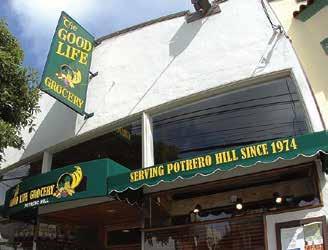








This November’s race for the San Francisco Board of Supervisors District 10 seat is shaping up to be nothing like the 2010 election. Four years ago 21 candidates competed for an office to be vacated by then-supervisor Sophie Maxwell, who was termed-out after having served 10 years in the position. This year Malia Cohen, who received the third most first place votes in that election, but won after multiple rounds of ranked choice voting, will square off against a much diminished crowd of would-be politicians.
The 2014 race will contain some familiar faces, however. Earlier this month Tony Kelly filed the necessary papers with the City to become a District 10 candidate. Kelly captured a dozen more first place votes than Cohen


in 2010, but ultimately lost the race to the now incumbent supervisor. The only other challenger who has declared her intent to run is Bayview resident and real estate agent Diane Wesley Smith, who also appeared on the 2010 ballot, but garnered just two percent of the votes cast.
Longtime community activist, Visitacion Valley resident, and fourth place finisher in 2010, Marlene Tran expressed interest in running this year, but hasn’t yet decided if she will. Tran said she’s been disappointed with Cohen’s work, especially within the Asian-American community. She cited the selling of the community center in Visitacion Valley, and the lack of access to bilingual municipal services, as two of Cohen’s failures.
In response to the former assertion, Cohen said that “Wells Fargo had foreclosed on the community center, and while the City was negotiating to buy it the bank sold it at auction.”
Kelly’s entry may make the District 10 election the City’s most competitive supervisors’ race. To date no candidates who have demonstrated the potential to win an election have come forward to challenge incumbents in districts two, four, six, or eight. Still, it won’t

I promise that when I’m supervisor, I, or my staff, will hold community office hours 11 times a week, every week.
— TONY KELLYbe easy for Kelly or any another candidate to unseat Cohen. Since 2000, a district-elected supervisor has never lost re-election. Christina Olague failed to win District Five in 2012 after she was appointed by Mayor Ed Lee, but she’d never been elected supervisor by the voters.
SUPERVISOR RACE page 11
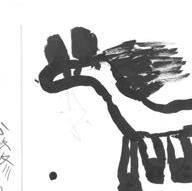
Eastern neighborhoods residents are calling on the City to fill a $134 million to $274 million gap in needed public infrastructure in their communities. The gap was recently estimated by the San Francisco Planning Department, and includes insufficient public transportation, open space and other amenities to serve a growing population in East South-of-Market, the Mission, Central Waterfront, Potrero Hill, Dogpatch and Showplace Square. And with an estimated citywide gap of $6.3 billion in needed transportation funds over the next 15 years, infrastructure requirements in the eastern neighborhoods may be even larger than Planning Department calculations.
“We are deeply concerned about the cumulative impact of thousands of new residents on our already overburdened parks, transit and other infrastructure,” said Alison Heath, a member of the advocacy group Grow Potrero Responsibly.
INFRASTRUCTURE page 4
A meeting at the Port of San Francisco held late last year led to two big changes in the design for Crane Cove Park. Dogpatch residents convinced the Port to move a development that had been slated for park property to a different area of Pier 70, creating another half-acre of green space in the park. And the Port will now work to construct the park’s northern shoreline sooner, perhaps as part of project phase one, which is expected to commence mid-2015.
“The community is ready for the park to be open,” said David Beaupre, the Port’s senior waterfront planner, planning and development. Beaupre added that some people don’t like the design, but residents are clamoring for more open space in the neighborhood in light of all the development taking place.
Crane Cove Park is part of historic Pier 70, an old shipyard that’s being renovated in a massive undertak-

ing that will bring residences, shops and offices to the now mostly decrepit shoreline. A slipway and two cranes, all three of which were used in ship building, will remain in the park. Overall, the redevelopment will open up 1,000 feet of shoreline to public access.
Located along Illinois Street, bounded by Mariposa Street on the north, and a proposed extension of
19th Street on the south, “Crane Cove is set to be one of the most celebrated new parks in the City,” according to the Port’s website. Besides featuring the history of shipbuilding, the park will provide a launching pad for humanpowered boats. The park’s northern shoreline will be beach-like, allowing
2 THE POTRERO VIEW February 2014
T he first time my sister, Marissa, asked me if she and two of her boys should climb Mount Kilimanjaro, the highest peak in Africa, I discouraged her.“Why would you do that? It sounds like a real slog,” I said.“Well, Simon wants to do it,” Marissa said.
Simon is Marissa’s oldest. After starting a post-college job at REI he’d dived into outdoor adventures, particularly mountain climbing. Marissa and I talked for a few more minutes about Africa, a continent I’d visited a dozen times, and alternatives to climbing Kilimanjaro, before saying our goodbyes. I thought she’d decided not to tackle the mountain.
“Do you want to climb Kilimanjaro with us,” Marissa asked over the telephone, a few weeks later.
“Huh? I thought you decided not to do that,” I said.
“Well, Simon convinced me that, other than the safari, it’s the best thing to do while we’re in Tanzania. Plus Asa said he’d do it.”
Asa was the youngest, a freshman at Johns Hopkins University. Since her husband, Harvey, died, every winter Marissa traveled with her three sons to a different international locale. But Elias, the middle son, had joined the Israeli army —he’d recently been shifted from elite special forces to the attack dog unit —and wasn’t available for this year’s trip. If not exactly his replacement, I’d take the slot he’d left open.
“Okay, I’ll do it,” I said, without much thought.
It’d be great to spend time with my sister and nephews; I was pleased to have been asked. And a good friend of mine had climbed the mountain a number of years ago; the main hardship he’d mentioned was the need to drink a lot of water, and having to pee all of the time as result. That seemed like a burden I could carry.
I
’m not much of a mountaineer. I climbed Mount Shasta, 14,180 feet tall, almost thirty years ago; the highest I’ve gone outside an airplane. I am, however, a dedicated walker, regularly hiking San Francisco’s hills and valleys, and rambling from my Mission District home to Dogpatch office. I was confident —perhaps to a fault —that I could scale Kilimanjaro, a massif that required determination and solid legs, but no technical skills.
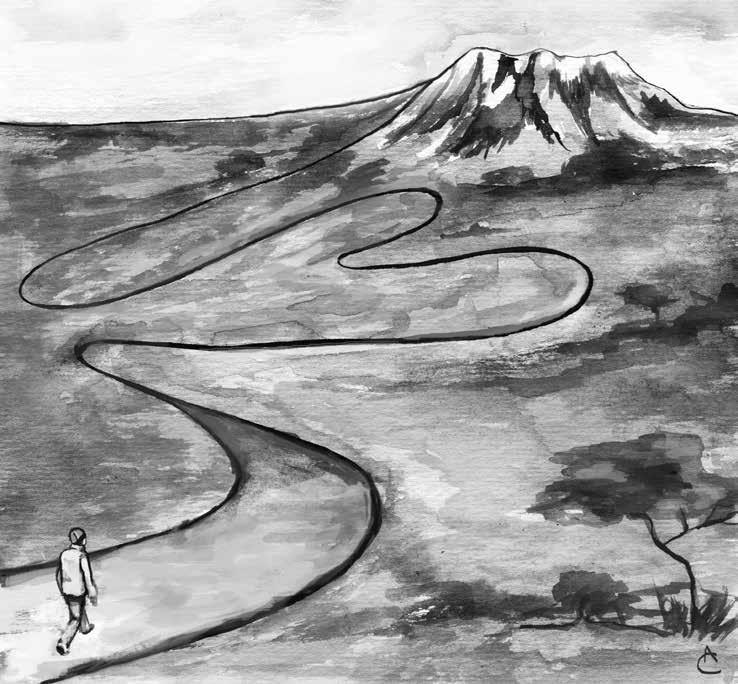
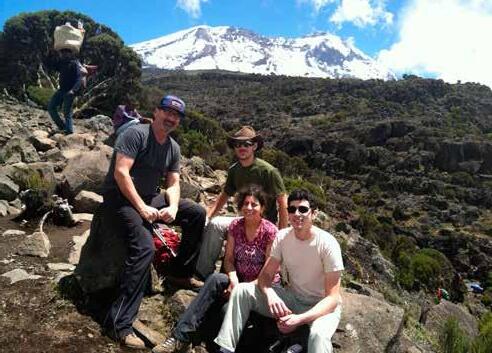
 PUBLISHER’S VIEW EDITOR and PUBLISHER Steven J. Moss PRODUCTION MANAGER J.Durrant THIS MONTH’S CONTRIBUTORS Keith Burbank, Morgane Byloos, Amy Curkendall, Debbie Findling, Amber Hawkins,Lisa Fagundes, Peter Linenthal, Catie Magee, Paul McDonald, Don Nolte, Brian Rinker, Mauri Schwartz, and Simon Stahl Editorial and policy decisions are made by the staff. All staff positions are voluntary. Published monthly. Address all correspondence to: THE POTRERO VIEW, 2325 Third Street Suite 344, San Francisco, CA 94107 415.626.8723 • E-mail: editor@potreroview.net • production@potreroview.net (for advertising) Copyright 2014 by The Potrero View. All rights reserved. Any reproduction without written permission from the publishers is prohibited.
PUBLISHER’S VIEW EDITOR and PUBLISHER Steven J. Moss PRODUCTION MANAGER J.Durrant THIS MONTH’S CONTRIBUTORS Keith Burbank, Morgane Byloos, Amy Curkendall, Debbie Findling, Amber Hawkins,Lisa Fagundes, Peter Linenthal, Catie Magee, Paul McDonald, Don Nolte, Brian Rinker, Mauri Schwartz, and Simon Stahl Editorial and policy decisions are made by the staff. All staff positions are voluntary. Published monthly. Address all correspondence to: THE POTRERO VIEW, 2325 Third Street Suite 344, San Francisco, CA 94107 415.626.8723 • E-mail: editor@potreroview.net • production@potreroview.net (for advertising) Copyright 2014 by The Potrero View. All rights reserved. Any reproduction without written permission from the publishers is prohibited.
“That’s completely irresponsible!” blurted Jeff, at a dinner party my wife, Debbie, and I were hosting, when I told him about my Kilimanjaro plans.
“What do you mean,” I asked, “It’s not like I’m climbing Everest.”
“You have a family,” he countered. “It’s just irresponsible.”
He shook his head and turned his attention back to his plate, signaling that this part of the conversation was over. I looked at his bowed cranium. It wasn’t the reaction I’d expected; most people I’d told responded with “cool!” or “I’m so jealous!” though one colleague looked me over and spat out, “You? You’re climbing Mount Kilimanjaro!?” as if I told him I was going to compete in the Ms. World competition.
I didn’t take Jeff’s admonishment too seriously; he was a luxury hotel kind of guy, and generally despised camping. But he was smart and successful. I found myself coming back to his remarks regularly throughout the climb, mentally fingering them like a smooth stone. Was I being irresponsible?
A van picked us up at our hotel near Arusha, and took us to a staging area at the base of the mountain. We joined small groups of adventurers huddled with their gear inside a large gazebo, speaking French, Portuguese, and Australian-accented English.
“We’re the oldest people here,” I said to Marissa, glancing around at the other climbers.
“I guess we are,” she said, grimacing. “But not the oldest who has ever climbed.” She’d previously read in a guide book that an 80 year old had made it to the top.
Simon and Asa joked about which of the international groups would die on the mountain.
“It’ll be the French,” Simon claimed, “It’s always the French.”
Our guide, Adronis, joined us, and introduced our support team, a ragtag crew of a dozen porters, a cook, and an assistant guide. They were dressed in what looked like clothes that had been discarded by previous climbers—North Face jackets; Columbia windbreakers—in various levels of grime and fit. Several of the porters wore boots that looked too large for them, or too worn.
“Do you all have climbing sticks,” Adronis asked.
KILAMANJARO page 8
(IMAGES OVER 200 DPI, PLEASE.)

A suspicious-looking fellow has been periodically spotted lurking around Potrero Kids at Daniel Webster during drop-off and pick-up times, occasionally taking photographs and making inappropriate comments. The middle-aged man has blond curly hair, wears a cap and a jacket with a badge that looks similar to a security guard, and rides a bicycle. If you notice anyone who doesn’t seem to belong in the area or makes you feel uncomfortable or threatened, contact preschool officials or the police (553.8090), who have been asked to increase their drive-bys by PKDW. Likewise, when accessing the building don’t let anyone that you don’t recognize into the facility.
The View’s photographer, Don Nolte, is increasingly concerned about camera theft in the neighborhood, having experienced such a robbery himself last year. “I take my camera all over the world and feel safe, but in my own neighborhood I don’t feel safe! Something is wrong here,” he said, in response to a New Year’s Eve strong arm robbery of camera equipment. In that incident four young black individuals in a grey Lexus stopped suddenly on 19th Street facing west. Two males jumped out of the back of the car wearing hooded sweatshirts, ran around the corner north on Texas Street, and attempted to steal camera equipment from a couple who’d set up to photograph the City view. They were
unsuccessful, but the equipment was smashed on the ground as they drove away. The couple was understandable shaken. The male victim said of the men threatened to shoot him for holding onto the camera, but no gun was seen. The good news is that last month the San Francisco Police Department (SFPD) apprehended two suspects in the mugging, and is in the process of prosecuting them…Officer Mel Thornton is covering for Sue Lavin, who is on temporary medical leave. Thornton has 30-plus years on the force, 20 of those in Bayview. After covering the homeless population for some time now, he calls himself “a garbage collector with a gun.” Apparently there’s a lot of trash out there…
After well less than a year of opening, NextSpace/NextKids Potrero Hill is expanding to occupy the second floor of its Vermont Street space to accommodate a waiting list of interested professionals. Next appears to be Now… Dogpatch-based Tree Ring Productions has launched an IndieGoGo crowdfunding campaign to raise $20,000 to provide 10 Bay Area nonprofits — including Bay Localize, Community Living Campaign, and Just One Tree with a promotional video, at no cost to them… Reclamation Etchworks, at 26th and Tennessee streets, repurposes recycled glass bottles by inscribing them with the names of classic liqueur agave, rhum, gin and tequila thereby turning the objects

Editor, I enjoyed Sasha Lekach’s piece on room sharing in this month’s Potrero View. (“Home-Sharing Online Services Here to Stay on Potrero Hill,” January). And while I realize the goal of the piece was not to get into the political and legal debate about room sharing, I feel there should have
into retro decanters that’d be at home in an episode of Mad Men, or, for the older crowd, Bewitched. Get your 1960s on!
The power of the press: perhaps as a result of a recent C.W. Nevius column in the San Francisco Chronicle about rapid rent increases in Dogpatch and Potrero Hill which was prompted by alerts from Keith Goldstein, Potrero Dogpatch Merchants Association’s (PDMA) president — one of the subjects of the article, photographer Emily Payne , received notice that her rent hike would be lowered, and delayed…Last October’s Potrero Hill Festival earned $10,000 for the Potrero Hill Neighborhood House. It marks the first time the event, now being managed by the PDMA, has turned a profit… Kieron Sinnette , ProLocal founder, was appointed by Mayor Ed Lee to the Local Business Enterprises Advisory Committee last month…Farley’s turns 25 in March, which prompted some age-related boasting at a recent PDMA meeting. Apparently, SFPD’s Bayview District is 168 years old, St. Teresa’s of Avila Catholic Church is 134 years
at least been some mention of the fact that in San Francisco it is illegal for individuals to rent out rooms for short periods of time; less than one month. Potential hosts should be aware of the risk of what is otherwise a fantastic service.
Andrew Jeffery, Kansas Streetold, the Potrero Boosters clock in at 88 years with some original members still attending meetings the View is 44 years, The Good Life Grocery is 40 years, and Goat Hill Pizza is 39 years old. Happy birthday to all!
Police, fire, or medical-related emergencies: 911
Non-emergencies: 553.0123
Bayview Station mainline: 671.2300
Watch Commander (Lieutenant’s Desk): 671.2325
Captain O’Sullivan, direct: 671.2303, cell: 590.1698
Beat Cop, Marquita Booth: marquita.booth@sfgov.org
Beat Cop, Mike Chantal: michael.chantal@sfgov.org


San Francisco’s Department of Public Works registered 2,000 objections to the installation of AT&T U-verse boxes on City sidewalks last year. That’s 80 percent of the total number of objections to permits the department received in 2013, according to Lynn Fong, DPW. Fong reported the statistics at an informational hearing held by the Board of Supervisors Land Use and Economic Development Committee last month.
“That’s an avalanche of objections,” Fong told the committee. Still, the citizen protests don’t seem to be enough to trigger a clause in the City’s memorandum of agreement with AT&T that says enough objections would prevent the company from installing their boxes on San Francisco sidewalks. In a response to a question from District 8 Supervisor Scott Wiener about what amount of opposition would be enough, Marc Blakeman, regional vice president, external affairs, AT&T, said that each box can serve up to 500 people. But AT&T receives only as many as 20 complaints about each installation.
“Four hundred and eighty are
silent,” Blakeman said. He wouldn’t say what AT&T’s share of the telecommunication market is, calling that information proprietary; despite its capacity, each box could be serving only 20 people. “It’s the fact that you now have an option,” Blakeman said. “That’s empowering to a consumer.” He added that people are asking AT&T when the service will be available in their area.
AT&T reported that it exceeded its hiring goal of 50 San Franciscans for jobs as technicians, recently hired 150 new technicians and 10 managers. It now has three garages in the City. The company plans to hire another upwards of 100 people during the first quarter of this year. At least one third of those jobs will go to San Franciscans.
Roughly 80 people shared their thoughts about the AT&T rollout during the hearing’s public comment period, with many opposed to the installations. A few supported the project. Craig Issod spoke on behalf of people who want the service. “I too don’t want San Francisco blighted,” he said. But that would mean he doesn’t want electricity or MUNI, he said. Issod doesn’t have U-verse service in his neighborhood, but he plans to sign
COME BE PART OF A WELCOMING, WARM, INCLUSIVE FAITH COMMUNITY
ST. TERESA OF AVILA CATHOLIC CHURCH SERVED BY THE CARMELITES
19TH STREET AT CONNECTICUT
Ash Wednesday, March 5
Mass with
Distribution of Ashes 12:15 pm & 6:15 pm
PRAYING WITH ST. TERESA OF AVILA
Two talks by Fr. David Simpson, O. Carm. former Carmelite Novice & Retreat Master
Wednesdays, March 19 & 26 at 7:00pm
Tuesdays in Lent Wednesdays in Lent Fridays in Lent Mass, 8:30am Mass, 6:15pm Mass, 8:30am
SUNDAY MASSES
Saturday Vigil 4:15 pm
Sunday 8:30 am 10:00 am
WEEKDAY MASSES
Tuesday 8:30 am
Friday 8:30 am
StTeresaSF.org
Phone: 415.285.5272
Email: info@stteresasf.org
up when it’s available.
According to Tony Kelly, a Potrero Boosters board member, AT&T has demonstrated a lack of willingness to work with communities. “We want the box to be on the sidewalk because it’s more convenient for our workers,” Kelly said an AT&T worker told him about an installation at 22nd and Wisconsin streets. That comment, Kelly said, “really poisons the dialogue.” Other hearing attendees said AT&T is reluctant to look for alternative sites for the boxes. Kelly said the City should facilitate placing boxes on public land when possible.
Heath made her comments at a San Francisco Board of Supervisors, Government Audit and Oversight Committee meeting held late last year. District 10 Supervisor Malia Cohen, committee chair, called the hearing to discuss the City’s strategy for funding the eastern neighborhoods’ infrastructure needs.
“ The Eastern Neighborhoods Plans propose to provide a full array of public benefits to ensure the development of complete neighborhoods, including open space, improved public transit, transportation, streetscape improvements, community facilities, and affordable housing,” Heath said, quoting the Planning Department’s website. She asked the City to deliver on its promises before allowing any ad-
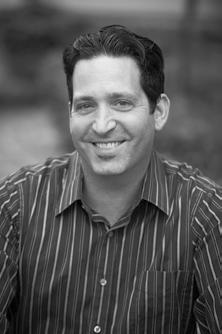
ditional developments to get underway.
At the hearing, Cohen seemed to agree with Heath’s concerns, asking City officials how they were going to keep their promises. John Rahaim, the Planning Department’s director, asserted that with the fees generated by developments the City is “fairly confident” it can provide some of the amenities identified in the Eastern Neighborhoods Plans, particularly with respect to open space and public facilities. But he stressed that all the infrastructure requirements reflected in the Plan weren’t supposed to be paid for with impact fees. Instead, the City typically leverages impact fees to secure money from other sources, such as state and federal grants.
According to the planning director, transportation and streetscape improvements “have a very high price tag,” but the Mayor’s Transportation Task Force has some ideas that may address those needs. However, Monique Zmuda, deputy City Controller and Task Force co-chair, provided details primarily on initiatives pertaining to the City as a whole, rather than focusing on the eastern neighborhoods. Zmuda indicated that San Francisco will have to spend $10.1 billion between now and 2030 to fund needed improvements to the City’s transportation infrastructure. If fully funded, some of the money would be allocated to meet the needs of the eastern neighborhoods. Of the $10.1 billion, the City currently has only secured $3.7 billion, from such sources as local sales taxes, federal funds, and monies from the Metropoli-
INFRASTRUCTURE page 12

By summer, construction will start to transform an historic Dogpatch bank building into luxury apartments. The building at 2290 Third Street was constructed in 1917, and most recently housed Pro Camera. Though opposition to development in the neighborhood seems to be growing, community members submitted eight letters to the Planning Commission in support of the project, with no letters of opposition recorded.
“It will be a high quality product,” said Brent Gaulke, Gerding Edlen, the project’s developer. Portland, Oregonbased Gerding Edlen specializes in infill construction. It recently purchased the property from Build Inc., which developed a successful project near Esprit Park.
Susan Eslick, vice president, Dogpatch Neighborhood Association, had positive things to say about Build Inc., but wants to know if 2290’s design has changed since Gerding Edlen bought the property. “If they do have changes, it would behoove them to contact the Dogpatch Neighborhood Association,” she said.
The project consists of 70 or 71 apartments. Several more five and six story buildings are planned for the Third Street corridor, which some residents fear may cause a “canyon effect.” Other residents, such as Eslick, believe that more people will benefit the neighborhood, including
struction on a project in Berkeley.


increasing safety.
According to Gaulke, 60 percent of the units will be one bedroom; 40 percent two bedrooms. On average, the one bedroom units will be 600 square feet in size, while the average size of the two bedroom units is slated at 900 square feet.
“We were lucky to get it,” Gaulke
said. Gerding Edlen is also developing a project at Sutter and Van Ness streets, and the company has just started con-
To preserve the building’s history before it’s demolished, Gerding Edlen is in the process of hiring an architect to document the edifice as it is now. Once the apartments are built, the documentation will become a history display inside the lobby of the complex. “That’s something we’re committed to,” Gaulke said.
Construction will take roughly a year and a half. Both the materials used in the building’s construction and the design will reflect the character of Dogpatch. Gerding Edlen hasn’t chosen colors for the building yet. Gaulke said he still has work to do with the Planning Department’s design committee.
The company hasn’t settled on rents for the apartments, but Gaulke said prices will be consistent with the company’s quality of construction and focus on sustainability. The building will capture storm water; units will feature low flow fixtures and energy efficient appliances.
The project is next door to La Scuola, an Italian immersion prekindergarten through eighth grade school. According to director Valentina Imbeni, the school doesn’t oppose the project, but wants to be 100 percent sure the children are kept safe from hazards during construction. Imbeni was impressed with the concern Build Inc. demonstrated to the school; she’s eager to meet with someone from Gerding Edlen. Gaulke said his company has placed two calls to the school, but it hasn’t had a face to face meeting with anyone yet.

Opposition to development in Dogpatch seems to have skipped at least one project. Plans are underway to construct 94 condominiums at the corner of Texas, 22nd and Mississippi streets, close by the 22nd Street CalTrain station. While the project hasn’t prompted widespread enthusiasm in the neighborhood, community members seem to agree that it’ll fill a need for additional residential activity.
“You have eyes on the street,” said Susan Eslick, vice president, Dogpatch Neighborhood Association. “People are coming and going. It completely changes the tenor of the neighborhood.”
Currently, the development site houses semi-industrial uses, though part of it is home to a program for adults with disabilities. According to the developer, Trumark Urban, the location looks like a fortress. It plans to change that image by building what it calls a “large scale boutique condo project.” Arden Hearing, Trumark Urban founder, asserted that his company is taking a site that’s underused and making it better. Trumark Urban fills a “niche that’s needed in neighborhoods,” he said.
Eslick disagreed with the fortress label, and called the proposed project ordinary. “I was not completely blown over by the design,” she said. “It wasn’t horrible.” But Eslick said not every project has to inspire opposition. And that seems to be what Trumark Urban’s goal. Hearing said his company isn’t pushing to increase height limits at the site, a popular tactic by developers in the area. A rendering shows the new structure would be roughly as tall as the houses adjacent to it on Mississippi Street. And Hearing said it’ll be lower than the residences across Texas Street.
Kim Diamond, development director, Trumark Urban, said the firm appreciates that the Eastern Neighborhoods Plan was 10 years in the making, and

we “respect and adhere to the vision in those plans.” She agreed that the project will provide an additional measure of safety at night for Dogpatch residents, a consideration for those arriving late to the CalTrain station.
Of the 94 units, Trumark Urban wants to build 32 one-bedroom condominiums, 59 two-bedrooms, and three three-bedroom condos. Sixty-six percent of the condos at the 645 Texas Street site would be two- or three-bedroom units.
The one-bedroom condos range in size from 580 square feet to 785 square feet.
The two-bedrooms are from 820 to 1,100 square feet, and the three-bedroom units range from 1,200 to 1,500 square feet.
In a meeting to discuss the project with the View, Diamond stressed her company’s efforts to address neighborhood concerns about the project.
Gathering input “is so critical to our process,” she said. According to Diamond, the company has met twice with the Dogpatch Neighborhood Association and twice with the Potrero Boosters. Eslick recalled seeing Trumark Urban only once.

Hearing and Diamond also stressed the project’s environmental aspects. The company has proposed solar hot water for the building, a green roof, a vertical garden near the building’s entrance, and electronic vehicle charging stations. And responding to neighbors’ concerns, Trumark Urban will landscape plants suitable to host the Bay Checkerspot butterfly, adding to existing habitat in the area.
That habitat may not exist, however. According to a 2010 U.S. Environmental Protection Agency fact sheet, the Bay Checkerspot butterfly is a threatened species, with the only known populations in San Mateo and Santa Clara coun-
ties. Threatened species are plants and animals whose numbers are so low they may become endangered.
Under Trumark’s proposal, 12 percent of the units will be affordable, spread throughout the building. The interior will feature an atrium and 94 secure bicycle parking spaces. Additional bike parking will be available outside.
Hearing expects construction to take 18 months. He’s aiming to go before the Planning Commission this spring, with shovel hitting dirt in late summer.
Potrero Hill is a great place to call home. I know because over the past decade,

The City’s plan to remove as many as 60 parking spaces along Potrero Avenue as part of the Potrero Avenue Streetscape Project continues to prompt fierce debate. Late last year attendees of a public outreach meeting on the project voted for a plan under which the spaces will be eliminated. But some community members, and at least one citizen’s group, continue to insist that the spaces be retained.
“Why not compromise?” asked MaryAnn Cheng, who has lived in the neighborhood for 35 years. She said the City’s plan to remove the parking spot in front of her home “for the greater good” isn’t fair. After speaking with San Francisco Municipal Transportation Agency (SFMTA) associate engineer Chris Pangilinan about parking, Cheng discovered that changes to the now preferred project option would retain her parking space. But SFMTA ignored the idea, and instead has decided to move ahead with the project as currently designed.
“Everyone seems to be more concern[ed] about the bicyclists and commuters from other neighborhoods who are entering our community,” Cheng said by email. “No one cares about the safety of the residents who [will] have to walk many blocks in the dark to get home.” According to Cheng, the City didn’t send her notices of the first two community meetings on the project, which she missed. And she and others have asserted that one or more notices indicated nothing about potential parking losses, an issue that would have brought scores of people to the meetings. Cheng’s email and letter to District 9 Supervisor David Campos were ignored.
“If you don’t live here, you don’t know,” said Renee Urizar, who lives next door to Cheng. Urizar stands to lose the parking space in front of her
home as well. Both Cheng and Urizar want access to spots within 30 feet of their homes. Urizar said she needs the space to shuttle her three-year-old and three-month-old children. And she said her mother, who lives with her, is getting older; Urizar fears for her safety. She claimed that parking space removal will bring traffic closer to her home. Recently, a vehicle struck her parked car, totaling it. She’s afraid next time an automobile will crash into her home. Project plans, however, indicate that a bicycle and dedicated bus lane will lie between automobile traffic and Urizar’s house.
“The system they had to get input was just not fair,” said Erick Argulo, president, Calle24, a coalition of 130 merchants, neighbors, nonprofits and artists along the 24th Street corridor.
Our responsibility should always be to address the needs of the most vulnerable users first.
— CC PUEDE, NEIGHBORHOOD GROUP SUPPORTING THE PROJECT
Argulo and others have argued that the community meetings were set up so residents didn’t have a chance to voice their opinion. The coalition is unanimously opposed to the project because it’ll remove parking for customers of 24th Street businesses. According to Argulo, Latino families travel to the commercial strip for products they can’t find in other neighborhoods, and those clients need parking. Argulo added that residential and commercial contractors rely on parking as well. And parking is vital to the Brava Theatre, which is just getting back on its feet after years of neglect.
“Our responsibility should always



be to address the needs of the most vulnerable users first,” said another neighborhood group, CC Puede, which supports the project. The group outlined its comments in a letter submitted to Mohammed Nuru, Department of Public Works director, last fall. “In this case, the most vulnerable are the patients traveling by bus and on foot to get their medical care. The proposed improvements will make the process safer for them.” CC Puede formed in 2005 to advocate for streetscape improvements to Cesar Chavez Street, and it “strongly supports similar improvements being proposed for Potrero Avenue.”
After five community meetings, the San Francisco Department of Public Works issued a letter late last year to the community describing its choice for the project’s design. “Option 1 envisions a variety of improvements along the Potrero Avenue corridor from 17th Street to 25th Street, all of which meet the established project goals of
improving pedestrian safety and accessibility, calming traffic, improving transit operations and reliability, and enhancing bicycle safety,” the letter said.
Improvements include a timesaving transit-only lane on the southbound side of Potrero Avenue from 18th to 24th streets. SFMTA expects the lane to reduce bus travel times by three minutes through the corridor. From 17th to 21st streets, plans call for pedestrian refuge islands at intersections, pedestrian bulb-outs at selected crosswalks, and a bicycle lane in both directions. At most midblock locations, a buffer zone will help protect cyclists from other vehicles. Between 21st and 25th streets, pedestrian refuge islands will be built at intersections, a continuous planted median will be installed and bicycle lanes will be created in both directions. On the east side of Potrero, from 22nd to 24th streets,


Public protests temporarily halted plans to cut-down nine large trees along Arkansas Street, between 18th and Mariposa streets, forcing a public hearing over the issue. But the trees could be felled after the late-January hearing takes place.
The trees are located on the east side of the block, adjacent to MacKenzie’s Warehouse, which is responsible for them. “It’s a giant safety concern,” Michelle MacKenzie-Menendez, owner of the warehouse, said of the trees, which have been subject to regular complaints from neighbors and the City. She’s afraid a falling tree will kill someone. “Their dangerous trees,” she said.
A public notice posted on the trees states that the plants are dead or nearly dead, though to a casual observer they appear healthy. New trees will replace the ones that are cut-down; the replacement species hasn’t yet been determined.
“The Director of the Department of Public Works has determined that the street trees must be removed in the interest of public safety,” states the notice. It also indicates that the trees are in distressed conditions: poor structure, elongated scaffold branches, and weak branch attachments. It adds that there have been repeated branch failures during the past year, which MacKenzieMenendez confirmed. She paid $5,000 when a tree limb damaged a truck.
“The owner has applied to remove the trees,” said a statement from DPW. “We then evaluated the health and structural condition of the trees and agreed that nine of them had enough structural issues to justify approving them for removal.” MacKenzie-Menendez’s permit for their elimination states that an arborist considers them to be hazardous.
The proposed tree cutting takes place along a block that’s slated to be developed into 320 residential rental units and roughly 10,000 square feet
of retail space by Related California. Lydia Tan, executive vice president, Related California, said her project and the tree cutting are unrelated.
DPW received two protests over the cutting, one from Debra Lardie, a Hill business owner who thinks the trees should be pruned rather than removed. “That’s a really big greenbelt,” she said.
“It’s a huge loss to the birds in the neighborhood. That’s my distress.” Lardie also thinks DPW didn’t give enough public notice before the tree removal started, and said the notices placed on the trees are difficult to see. Not only do the notice’s color blend into the tree trunks, but DPW placed them facing the property rather than the street. DPW insisted that it followed proper protocol.
“By pushing responsibility for the maintenance of street trees onto property owners who are unable or unwilling to properly maintain them, the City and County of San Francisco unfortunately guarantees that many of those trees will eventually endanger rather than benefit the public,” said Dan Flanagan, executive director, Friends of the Urban Forest, which promotes a larger and healthier urban forest. “Other cities recognize that street trees are a vital part of the urban infrastructure, and maintain them just as they maintain the roadways, water and sewer systems.

KILAMANJARO from page 2
“Everyone but me,” I responded. “I don’t use them.”
Adronis eyed me skeptically. “Okay,” he said. “Let’s go.”
We were on the seven day Machame route, which Marissa had chosen as having the greatest diversity of landscapes, as well as most likely to give us the time we needed to adjust to high altitude. The vast majority of those who attempted this route summited. On the first day we climbed to Machame Camp, a mildly threatening 9,350 feet. We hiked for roughly five hours through a forest of low trees and brush, spotted with colorful flowers, reaching our campsite in the late afternoon. Our tents had already been pitched, with dinner of soup and fried fish soon on its way. After playing a round of cards in the small dining tent that our porters had erected for us, we all retired early, tired, but looking forward to the next day. We were on our way.
The new draft Urban Forest Plan for San Francisco calls for the City to establish a dedicated funding source to replace its grossly inadequate urban forestry program with the kind of robust urban forestry program its citizens want and deserve.”
In the morning we headed to Shira, 12,500 feet high. As I grunted up the steep trail, I noticed that breathing had become more difficult. Three hours into the day we stopped for a picnic lunch of hardboiled eggs, crackers, and a mostly inedible cucumber sandwich with a wedge of lard pushed into the bread — we’d be issued this same ration for the next three days; for all we knew it was the same rejected portion — sitting on rocks with spectacular views
KILAMANJARO page 23


With its flat expanse of grass, in a neighborhood with a scarcity of green space, Esprit Park has attracted dogs and their owners since it was transferred to the City in 2001. Depending on the time of day, multiple off-leash animals can be found roaming freely. But, according to municipal law, the park is restricted to on-leash use only, and it wasn’t originally developed as a dog park.
In 1980, the Esprit Corporation purchased the land on which its namesake park now exists, and knocked down the existing ramshackle buildings. Douglas Tompkins, Esprit’s co-founder and chief executive officer, hired Drew Detsch to design and build a park. According to Detsch, Tompkins wanted to create a place for Esprit employees that would also benefit a neighborhood in transition. The park was built in two years; Tompkins refrained from fencing it in to allow community members to enjoy it. Initially, a few “no dogs” signs dotted the space, which generally kept the animals away for the next 20 years.
By 1996, Tompkins and his thenwife Susie Tompkins Buell had lost control of Esprit. The company’s new owner, Jay Margolis, decided to sell the parcel on which the park was located to be developed into a condominium complex. In response, Dogpatch residents formed Friends

of Esprit Park, raising $35,000 to save the park. But, even with another $1 million from the City’s Open Space Fund, it wasn’t enough to buy the property, which was estimated to be worth between $4 and $5 million.
Pressured by Friends of Esprit Park, in 2001 the Willie Brown Administration arranged a “clever land swap,” according to Detsch, between Esprit Park and a parcel located at 16th and Illinois streets. The park was saved. But the City wasn’t prepared to maintain its new acquisition. The “plants began dying,” said Detsch, and the irrigation system quickly
deteriorated. In response, the City cut down the plants. “As the park degraded, people stopped coming,” Detsch said. Dog owners let their dogs run off-leash in the denuded, underutilized space.
In 2003, the City dedicated $1.2 million from the Open Space Acquisition Fund—bond monies dedicated to purchasing park land—to rehabilitate the park. The irrigation system was replaced, and a new lawn installed. “It was unbelievable, really,” Detsch said. “But after it was completed, dog owners returned.” In an attempt to create barriers between people, plants, and dogs, Janet Carpinelli, now president of the Dogpatch Neighborhood Association, led an informal effort to designate areas of the park off-leash, but without a fence dogs continued to traverse the open space without restriction.
According to San Francisco Health Code Section 41.12, “All dogs must be leashed or tethered except in designated exercise areas.” There are two off-leash dog areas in Potrero Hill — at the Potrero Hill Recreation Center and McKinley Square — and 28 throughout San Francisco.
Over the years, in various bursts of intensity, Dogpatch residents have complained that Esprit Park isn’t a pleasant place, especially for families, as it’s polluted by animal waste and the lawn is degraded. “Do we play there? On the sidelines,” said AK Smith, a Dogpatch resident and mother of a two-year-old. “If we bring a ball, it gets taken by the dogs. So we go to look at the trees and watch the
dogs, but we never ever play on the grass. I’ve learned my lesson.”
“I can understand other people’s concerns,” said Steve Sacks, dog owner and Dogpatch resident since 2001. “But if you have a toddler, maybe you don’t need such a big park. But I don’t want to sound so exclusive.” Sacks insisted that if dogs are aggressive they should be put on-leash. He added that, although there are technically two parts to the park—one for on- and one for off-leash—dogs don’t respect the tree-lined division in the middle of the park. He said the only thing that would limit dogs from freely roaming would be a fence.
Some dog owners respect the offleash regulations. “I am a dog owner, and I like to take my dog out but there are places to do that,” said Detsch. According to Detsch, who still sits on the board of Friends of Esprit Park, “the dog owners love their dogs and shout loudly, and the City doesn’t enforce regulations.”
San Francisco Recreation and Parks spokesperson Connie Chan encouraged Dogpatch residents to call 311 to report any park issues. However, she said it’s difficult to enforce the rules, as the department is understaffed. “It is not easy for urban living with such a diverse population with such different needs,” Chan said.
Prompted by Friends of Esprit Park, the City replanted upwards of 30 new trees at the park last year. However, Detsch said the lawn is too
ESPRIT page 11


Low interest rates and powerful demand have made the market on Potrero Hill stronger than it has been in years. Many homes are attracting multiple offers after just a few days on the market.
If you have been thinking of selling your home this may be an excellent time to take advantage of strong demand from buyers. 1817
1425
1624
2004
2106

Lic:
415.710.9000
tim@timjohnsonSF.com
www.timjohnsonSF.com
degraded and under too much pressure to be rehabilitated without being replaced because of dogs skidding and running. He emphasized that on-leash dogs don’t have much of an impact on the grass; the main problem comes from free ranging dogs.
“If the neighborhood got together I think we could find a very nice common ground for everyone, like at Duboce, where I used to live,” Smith said. “I sincerely hope people can work together to get to a fun place for the neighborhood. Everyone loves dogs here. It would be nice to give humans —big and small— some space as well”
running. View publisher Steven Moss, who came in fifth place, said he gave the office his best shot in the last election, and had moved on to other things. Chris Jackson has relocated to the East Bay. Teresa Duque was cut out of the district when it was redrawn. First place finisher Lynette Sweet lost her spot on the Bay Area Rapid Transit board in 2012. She didn’t respond to messages from the View
“If it is going to happen,” said Kelly, referring to the City’s first upset of a district-elected supervisor, “it is going to happened here, in District 10.”
Kelly and other challengers have some cause for optimism. After the 2010 election District 10’s boundaries were redrawn. Portola, a small neighborhood that primarily voted for Cohen – she was raised in that community – was shifted to District 11. District 10 retained Bayview, Dogpatch, Potrero Hill, and Visitacion Valley. And since there’s an incumbent, the race will feature fewer serious challengers, allowing voters a less crowded forum in which to get to know candidates before voting.
Several of the top eight candidates in 2010 have confirmed that they aren’t
According to Kelly, the new district lines and smaller candidate pool are game changers. But he’s not relying on these variables to win the election. Kelly plans to campaign hard. Sitting in a Potrero Hill cafe, eating a ham and cheese croissant and drinking an orange juice, he made his first political commitment: “I promise that when I’m supervisor, I, or my staff, will hold community office hours 11 times a week, every week.” Kelly added that means he’ll hold office hours for community input daily in Bayview, three times weekly in Visitacion Valley and once a week in Potrero Hill. Cohen holds regular community office hours once a month for an hour and a half.
“Let’s be clear,” said Kelly, “our problems in District 10 are literally life and death issues; it is more real here.” Poor air quality, ground and water pollution, crime, stress, diabetes, economic instability, unemployment and housing affordability are some of the issues at stake for district residents, according to Kelly. Kelly said that the life expectancy in District 10 is 14 years shorter than in Russian Hill. Kelly, Tran, and Smith all complained that Cohen has
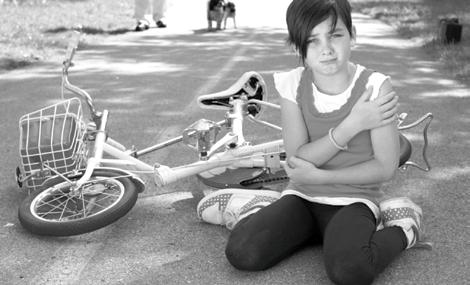

An entire block of sidewalk fronting 1401 Fourth Street—the Strata at Mission Bay building—has sunk three to four inches below the structure’s base. The sidewalk was laid just two years ago; it may have begun sinking soon after it was poured. Buildings in Mission Bay are built on Bay mud; the ground underneath the sidewalk may have settled when moisture in the clay material was displaced. Fortunately, the sidewalk’s movement hasn’t affecting the edifice’s integrity.
“We have been advised that the settlement of the sidewalk has not damaged the structure,” said Rachel Gordon, spokesperson, San Francisco Department of Public Works. According to DPW, the Strata sits on piles, and isn’t moving. The sidewalk, however, lies on compressible soils, which are sinking.
At one time Mission Bay was a tidal cove connected to San Francisco Bay. But beginning in 1859, the cove was filled-in with sand from other parts of the City, according to Vanished Waters: A History of San Francisco’s Mission Bay by Nancy Olmsted. Today the former cove is increasingly populated by housing developments, and the University of California, San Francisco-Mission Bay campus, with a new hospital set to open early next year. All that’s left of the tidal cove is Mission Creek, which stretches from AT&T Park to Seventh Street.
According to Justin Whitsitt, Strata at Mission Bay’s property manager, the
sidewalk’s subsidence never posed a risk to the apartment building’s residents. Though plans to repair the sidewalk are underway, nothing has been approved by the City yet, Whitsitt said.
“A minor encroachment permit application has been submitted to Public Works’ Bureau of Street Use and Mapping to provide a temporary wood ramp for one of the doorways,” Gordon said by email. “We have been informed that drawings are under way to provide an interim solution at all building entrances by use of pavers and concrete.” One wood ramp was already in place last month. “We expect that after construction of the interim work, drawings for a long-range solution will be prepared to replace the sidewalk,” Gordon added.
Michael Hamman, a local general contractor, said most likely the developer failed to adequately supervise the sidewalk work. “That’s not normal,” he said of the subsidence. Hamman said the ground underneath the sidewalk is supposed to be compacted and tested before concrete is laid. If not, or if there are voids in the underlying ground, the sidewalk can collapse.
According to Darrin Ketter, regional manager, Sares Regis Group, which manages Strata, neither the company nor the building’s residents have concerns about the structure’s integrity or the safety of residents. He said that brick pavers will serve as either a temporary or long-term solution to the sunken sidewalk, with permits for pavers filed late last year. Work is likely to begin this month.

Third Rail is Dogpatch’s latest cocktail hot spot, opening on 20th Street, close to the Third Street intersection, late last year, in a location that formerly housed Retox bar. With 28 years of experience in the industry, owner Jeff Lyon has developed a menu which boasts unique cocktails, with nine different types of jerky available for munching. “Cowboy Jerky” is doused with pineapple juice, onion and jalapeno; Landjager, on offer for $2.50 each, is made from pork, beef, cane sugar, and mustard seed.
Upon walking into the dimly lit interior, it’s hard to miss the large 20th Century clock, which used to be part of a French train station, and helps contribute to a midcentury-modern vibe. Third Rail’s cocktails are inspired by imaginative combinations of various herbs and fruits, such as pear and absinthe. “I also like to offer stylistic variety, which inspired the four-section menu” Lyon said. “People can choose from boozy spiritdriven cocktails, light, refreshing low-proof drinks, seasonal drinks or
tart, citrus-driven drinks”.
It can be tough to infiltrate tightknit Dogpatch, but Lyons said that the neighborhood has quickly embraced Third Rail. “The residents are very protective and proud of their turf, but so far everyone seems very excited about what we’re doing”.
Lyon’s favorite cocktail is the Spotlight, which includes manzanilla sherry, pear eau de vie, ginger liqueur and celery bitters. “It’s a weird combination of flavors that comes across almost savory. It’s not for everyone, but those who like it, love it!”
People can choose from boozy spiritdriven cocktails, light, refreshing low-proof drinks, seasonal drinks or tart, citrus-driven drinks
— JEFF LYONS, OWNERThe bar’s three most popular drinks are the Third Rail — buffalo trace bourbon, Lillet, honey, lemon, orange bitters — Double Date — date infused rye, George Dickel whiskey, sweet vermouth, Amaro, cinnamon bitters—and Fireside Sour; mescal, Cara Cara, lemon, agave, egg white, orange bitters.
“Yeah, we have fancy ice and we’re shiny and new, but at our core we’re just a regular bar offering tasty things,” said Lyons.
Third Rail is open seven days a week, 3 p.m. to 2 a.m.
tan Transportation Commission.
Both Potrero Boosters representative John deCastro and Keith Goldstein, an Eastern Neighborhoods Citizens Advisory Committee (ENCAC) member, told hearing attendees that the City has no clear plan on how to fill the infrastructure funding gap. “Hope is not a strategy,” deCastro said. “And I heard that a lot this morning from a lot of the presenters from the City departments.” As an example, deCastro said that the City has identified only one percent of the funding for needed San Francisco Municipal Transportation Agency equipment. He added that the City keeps saying it’ll get federal grants, but officials haven’t identified which grants; a critique Cohen echoed during Zmuda’s presentation.
During public comment, Boosters board member Tony Kelly suggested using property tax revenue to fund the infrastructure gap. Kelly calculated that more property taxes will be generated than estimated by the Planning Department. According to his estimates, 8,858 housing units are currently in the Planning Department’s project pipeline for the eastern neighborhoods, while the City expected only 9,000 units to be built by 2040. Kelly said that the nearly 9,000 housing units will generate $44.6 million in property tax revenue annually, compared with a Planning Department estimate of $8 million. In 15 years, that difference will add up to more than $500 million in unplanned revenue for the City’s general fund.
“That’s a half a billion dollars that nobody planned to get. Why can’t we say to the City, ‘why can’t we split it?’” asked Kelly, who ran for District 10 Supervisor in 2010. Kelly predicted ‘no’ will be the City’s answer, but he said that’s when the neighborhoods need to stand up. “That’s our only way out,” he said.
Chris Block, chair of ENCAC, a committee that advises the City on the use of impact fees, also expressed concerns about the infrastructure gap. His solution would steer the unanticipated impact fees generated through accelerated development to the neighborhoods’ infrastructure needs. He said the communities need the additional infrastructure to be fully functional. The current situation is like baking a cake, he said. If a cook leaves out ingredients, “it will be a lousy cake. That’s the risk we run in the eastern neighborhoods.”



To celebrate the New Year, Leslie Goldberg, owner of Hazel’s, “planted” a “Gratitude Tree” in front of her sandwich shop, on which passersby hung notes indicating things in their life for which they are grateful. Family was an oft-featured topic.
CENTER PHOTOGRAPH









The View asked Hill resident and career expert Mauri Schwartz to answer questions from job seekers.

Q: Help! I have an interview coming up and I don’t know what to wear. I know the world has changed since the last time I looked for a job, and people aren’t wearing suits any more, but what should I wear instead?
A: At a time when hardly anyone dresses for anything anymore, it’s hard to know how to dress for an interview. The old rule used to be to wear a suit — men and women — for any business interview. We all know that’s not the case anymore.
Recently I purchased tickets for an evening cabaret performance in San Francisco. This is how they described their dress code: “We ask that our guests do not wear shorts, baggy, torn or ripped jeans, athletic gear, sandals, ball caps, chains, or sweatshirts or shirts with hoods. Cocktail attire is recommended or nice denim.” Cocktail or nice denim? What a choice! And I can’t tell you the last time I went out dressed in athletic gear! For this venue, it seems that any reasonable outfit would be fine.
It’s a bit trickier when it comes to interview attire. And it totally depends on the situation, mostly the company and its industry. Most companies have adopted a casual dress code; you may see employees dressed in jeans, especially in the technology industry. However, you shouldn’t go to an interview in jeans or shorts. The best rule of thumb is to dress up one or two levels. Business casual clothes are most often appropriate: nice slacks/skirt, with a button-up shirt/ blouse or an appropriate sweater. Add a jacket, and in many cases, a tie, for men of course.
For most traditional business situations, you’ll want to dress up a notch; a jacket for sure and sometimes a suit. This is especially true for companies in finance, management consulting, and others with customer facing roles. Recently I delivered a presentation to a group of employees in a large financial services corporation, a traditional, conservative environment. I wore my nicest suit, and carefully observed attendees’ clothing. All of them were dressed in “formal” business attire. The men in dark suits with white or light blue shirts and fairly conservative ties. The women were noticeably fashionable, almost every one. Not trendy, but up to date and appropriate for the occasion, including a few dresses, mostly with matching jackets.



As part of your research in preparing for the interview, investigate the company’s “dress code” by asking a friend if you know someone who works or has worked there, or by calling human resources. It’s most important to wear clean, pressed clothes and freshly polished shoes. In deciding between choices that meet these criteria, choose the outfit that you feel most comfortable in. I hope I don’t need to say that you must not wear anything that’s sexy or shows skin between your neck — or a bit lower — and knees. You want the interviewer’s attention to be focused on you and your qualifications, not your cleavage or clothes, or jewelry.
Additional tip: Since many people have allergies/sensitivities to perfume, be careful with fragrances. Most body and hair care products are scented. Choose products that are fragrance-free or have a faint smell.
Mauri Schwartz is







 Happy Birthday, my little gift from the universe! Nine is very, very grown up. Love Mommy
How is our sweet, silly buddy already Four? Happy Birthday Dashiell! Love, Mommy, Daddy, Ava, and the furry family members
Happy Birthday, my little gift from the universe! Nine is very, very grown up. Love Mommy
Happy Fifth Birthday George! Love, Mom, Dad and Marie
Highly competitive and famously complex, the San Francisco real estate market can be both challenging and rewarding. Zephyr turns savvy, informed Bay Area urbanites into successful homeowners, investors and sellers. ZephyrSF.com
Happy Birthday, my little gift from the universe! Nine is very, very grown up. Love Mommy
How is our sweet, silly buddy already Four? Happy Birthday Dashiell! Love, Mommy, Daddy, Ava, and the furry family members
Happy Birthday, my little gift from the universe! Nine is very, very grown up. Love Mommy
Happy Fifth Birthday George! Love, Mom, Dad and Marie
Highly competitive and famously complex, the San Francisco real estate market can be both challenging and rewarding. Zephyr turns savvy, informed Bay Area urbanites into successful homeowners, investors and sellers. ZephyrSF.com


The Library will be closed on February 17 for President’s Day.
Reference Drop-In—One-on-One Time for more Intensive Reference Questions: Do you have questions on how to use computers and the internet, how to download eBooks to your device, or how to use the library’s databases? Come to Reference Drop-In, where you will get one on one time with a librarian to help answer your toughest conundrums! Wednesdays, February 5, 12, 19, and 26, 6:30 to 7:30 p.m. Black Films on the Red Carpet—Award winning films starring African Americans: In honor of Black History Month and the beginning of Hollywood’s Award season, award-winning movies will be shown about African Americans. Thursday February 6, 5:30 to 7:30 p.m.: Glory, Sunday February 9 2 to 4 p.m.: The Defiant Ones, Thursday February 20 5:30 to 7:30 p.m.: Do the Right Thing, Sunday February 23 2 to 4 p.m.: The Color Purple
Paper Flower Bouquets Workshop Come get crafty with Flowers in Your Hair floral designer, Misti Boettiger. Learn to make festive paper flowers out of recycled materials and create a whimsical bouquet to take home or give to a loved one. For ages 12 and up only. Supplies provided, but scissors are limited, so bring your own if you can! Program limited to 20 people. To sign up or more information, contact Lisa at lisa.fagundes@sfpl.org or call 355.2822. February 7, 3:30 to 5:30 p.m.
Game On! Video Games for teens: Come play PS3 games on our big screen. We have a selection, or you can bring your own T or E rated games to share. Challenge your friends to determine who is the ultimate gamer. Ages nine to 19 welcome. Tuesdays, February 4, 11, 18, and 25, 4:30 to 6:00 p.m.
Frog and Toad Story Time and Craft: Frog and Toad fans get inspired by Arnold Lobel’s art through a story followed by a related craft making program. Presented in partnership with the Contemporary Jewish Museum’s Frog and Toad and the World of Arnold Lobel exhibition on display until March 23, 2014. Saturday February 1, 4 to 5:30 p.m.
Six Roses Jazz Music: In celebration of African American Heritage Month, Six Roses will perform original jazz tunes for children of all ages.Saturday, February 22, 4 to 5 p.m.
Baby Rhyme and Play Time: Songs and rhymes for infants up to 18 months old and their caregiver. Tuesdays, February 4, 11, 18, and 25, 1:15 to 1:45 p.m.
Family Story time: Featuring stories, songs and rhymes. For children from birth to five years old and their caregiver. Thursdays February 6, 13, 20, and 27, 10:30 to 11 a.m. and 11:15 to 11:45 a.m.
Homework Help: K–3 students will receive one-on-one help from our capable volunteer. Need homework support? Drop by the library for free assistance. Tuesdays February 4, 11, 18 and 25, 4:30 to 6 p.m.
Fun Flicks: This film program is offered every second Wednesday of the month and includes short films based on children’s books and stories. February’s films are: Liang and the Magic Paintbrush; Lon Po Po; Sylvester and the Magic Pebble ; Seven Chinese Sisters. For children 3 to 8. Bring a snack and enjoy the show! Wednesday February 12, 6:30 to 7:15 p.m.
Movie Day: In partnership with the Potrero Hill Family Support Center (PHFSC), we will present Cars and PHFSC will provide a meal. Friday, February 21, 3 to 5:30 p.m.
Creative Writing Workshop: A free class to help you write your own stories, develop your characters, and find your own unique voice in a supportive and creative environment. Please contact Shevi for more information: sheviros@ gmail.com or 602.7961. Thursdays February 6, 13, 20, and 27, 12:30 to 2:30 p.m.
The Potrero Hill Book Club : Meets at the library every third Wednesday of the month. January’s selection is The Submission by Amy Waldman Join the discussion on Wednesday February 19, 7 to 8 p.m.
San Francisco Seed Library at the Potrero Branch Library: In partnership with the San Francisco Seed Library, the Potrero Branch Library has seeds available for “checkout.” Located on the 1st floor beneath the staircase.
sidewalks will be widened.
Cheng and others have argued that the San Francisco Bicycle Coalition stacked the meeting with its members to vote for the option that best serves cyclists. But Leah Shahum, the Coalition’s executive director, said her members live throughout the City.
Cheng also disputed SFMTA’s claim that 250 cyclists use Potrero Avenue daily. She counted 45 cyclists passing by her home one day. But according to the Coalition, Potrero Avenue is an important connection between neighborhoods. And there are no bike lane projects planned for nearby streets, said Chema Hernandez Gil, a Coalition community organizer, though some residents have proposed moving the bike lanes to another street, such as Hampshire. Shahum added that the project is also about pedestrian safety, which she called paramount.
Residents have wondered whether the planted median would obstruct emergency vehicles from getting to San Francisco General Hospital during rush hour. Emergency vehicles regularly have to use a center lane that’s off limits to traffic during peak travel hours. But, according to Mindy Talmadge, public information officer, San Francisco Fire Department, “Fire Department officials had a favorable [meeting] with MTA and DPW in which a dialogue took place. The Fire Department also had concerns about the median as it was planned. We
submitted a suggestion that breaks in the median be included in the design. The suggestion was met with a favorable response.”
Tristan Cook, San Francisco General Hospital Rebuild public relations director, said the hospital, “the San Francisco Department of Public Works, the San Francisco Fire Department and the Emergency Medical Services division are working together to review the Potrero Avenue Streetscape plan to ensure that patients can be safely and quickly transported to the City’s busiest emergency room and only Level 1 Trauma Center.”
Another public hearing on the project may come as early as this month. Following the hearing, the matter will go before SFMTA’s board this month or next. At the hearing, the board will take public comments before rendering a final project decision.
and over a mile from the site,” Beaupre added.
Paul Nixon, a Central Waterfront Advisory Group member and human-powered boat advocate, is excited about the sandy shoreline. Work to create access for human-powered boats has been going on for several years, he said. And he agreed that building the shoreline as part of phase one is a big change, insisting that it’s time to move ahead with the park.

residents to put in kayaks, rowboats, dragon boats, and whaleboats.
“This is one of the very few, if only, places along the Port’s waterfront where we can have a beach-like shoreline edge,” Beaupre said. Kayakers and other boaters find sandy beaches the easiest shoreline from which to launch their small vessels. A sandy “shoreline does not exist or is not feasible on any other Port property, north or south, except within Islais Creek, which is very limited
“People are interested in us delivering a park,” Beaupre said. There’ll be additional opportunities for interested parties to weigh in on park design, but in general the Port believes it’s reached a consensus with the community on how to proceed. The park will be developed in two or three phases, depending on when the Port secures the needed funding for the project. Plans are for the park to be open in late-2015 or early-2016, though funding challenges could delay completion until 2019.
So far the Port has earmarked $23 million for the development, which it expects to cost $45 million, or $5 million per acre. Additional possible funding sources include tax increment financing, future park bonds, and grants.
“This is going to be a really cool park,” said Matt O’Grady, executive director, SF Parks Alliance. “More
park sooner. We like that.” O’Grady said that the Port has done a good job of gathering community input on the project, as well as balancing competing interests. His only concern — and a theoretical one at that — is if the project stalls out.
This spring the Port will seek review and approval of the park’s final blueprint, including grading details, the construction materials to be used, and key design elements. During the summer, the Port will vet materials for the park’s pathways, tables, benches, lights, signs and other amenities. Meetings will be open to the public, though dates for future gathering haven’t yet been set.
More information about the park and its design can be found at sfport. com/cranecovepark
 POTRERO STREET from page 6
CRANE COVE PARK from Front Page
POTRERO STREET from page 6
CRANE COVE PARK from Front Page
been an “invisible” supervisor.
A twenty year District 10 resident, Kelly founded and managed a theatre company, Thick Description, until 2010, when it became financially unviable. He served as president of the Potrero Boosters for many years, most recently between 2011 and 2013. He earns a living as the art director for the San Francisco Symphony’s Playbill, and as a freelance theatre director. Kelly helped organize the successful ballot initiative to stop the Eight Washington condominium project, and has lead community opposition to installation of parking meters in Dogpatch, the Mission, and Potrero Hill.
Cohen held a campaign fundraiser in December; the amount she’s collected so far will be made available online at the Ethics Commission sometime this month. But the supervisor said that it’s too early to talk about the election. Instead, she pointed to her recent accomplishments, including, in collaboration with District Six Supervisor Jane Kim, introducing legislation to stop asking applicants if they’ve ever been convicted of a misdemeanor or felony on job and affordable housing applications. According to Cohen, the criminal check box is a “barrier to entry,” causing those with criminal backgrounds to be denied jobs and housing. Under her bill employers could still ask applicants about their criminal history, and run background checks. The proposal is meant to help applicants with checkered pasts get their foot in the door.
To help address obesity and high diabetes rates in Bayview, Cohen supports a two percent per ounce tax on sugary beverages, an idea that’s being pushed by at least two other supervisors. Other cities have tried similar soda taxes; all have failed. Cohen also said she helped expand the 22 bus line into the Southside neighborhoods, a change that’ll be completed in 2015, with new diesel hybrid buses replacing the overhead wire ones.
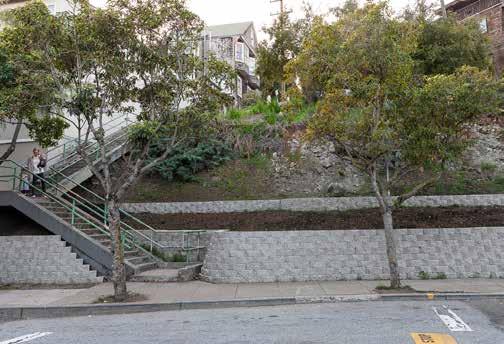
Roughly four years ago, Sara Harreld Lai and her husband, Mike, moved from Dogpatch to a renovated home on Arkansas Street. Soon after, the couple had the first of their two children. With motherhood, Lai started spending more time walking the neighborhood, often passing an overgrown patch of land surrounding an aging stairway that connects Wisconsin Street at the top, to Arkansas Street at the bottom. The stairway is


effectively the continuation of 22nd Street; the hill is too steep for 22nd to continue as a road.
Lai became concerned about her walking route after several muggings took place at a bus stop at the foot of the stairwell. After participating in a monthly S.A.F.E. neighborhood watch meeting at which the issue of crime occurring on the neglected stairway and adjoining patch of land was discussed, she decided to organize “The 22nd Street Steps Project.”
The project’s first step was to identify who was responsible for the land, which ended up being a mix of public—the City—and private— adjacent homeowners-entities. Lai equated the public-private ownership to a sidewalk: publicly owned, but privately maintained.
After receiving advice from Annie Shaw, who created the Pennsylvania Street Garden at Mariposa and Pennsylvania streets, last April, on Earth Day, Lai and upwards of 30 other volunteers spent the day cleaning, cutting and clearing the area. The strip’s full potential began to emerge. Lai spearheaded an effort to raise funds to





construct a retaining wall, collecting nearly $12,000 in contributions from almost 30 households. With a portion of that money, an attractive curved concrete retaining wall has been installed, setting the stage for further improvements.
Future plans for the area are to paint the railing, add plants and get the City to make repair existing water pipes, all of which is targeted to take place this spring.
For further information: saraharreldlai@gmail.com.



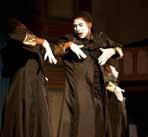
Artwork by Starr King students
Coordinated by Christina Quiroz
2014 is considered as the Year of the Horse in the Chinese Zodiac Calendar which begins on January 31, 2014, and ends on February 18, 2015. According to Chinese Astrology Calendar, 2014 is the Year of Wood Horse. Wood is related to trees or green, so it is also called Year of Green Horse. The Chinese zodiac calendar comprises 12 animal signs and horse is the seventh among all of them. In Chinese culture, the Horse is a symbol of nobility, class, speed and perseverance. People born in the Year of the Horse are thought to be smart and great speakers who have a gift for reaching people with their words.










February 1 through March 15
Art: MIND // SPACE
MIND // SPACE is an exhibition of work by San Francisco based artists Craig Dorety and Tenkai Kariya. Working in adjacent studios at the Cataclysmic Megashear Ranch in the Bayview, Dorety and Kariya have created complimentary bodies of work using 21st century tools and materials to produce afuturistic collection of images, sculptures, and light objects. Yesterday’s craftsman meets today’s hacker/maker. Reception, February 1, 6 to 8 p.m. Dogpatch Café and Art Gallery, 2295 3rd Street. Information: dogpatchcafe.com
Feb 1, 8, 15, 22
Kids: Drop-in Saturdays at the Randall Museum
The Randall Museum offers popular drop-in, hands-on art and science workshops every Saturday! Family ceramics starts at 10:15am ($5 per person) and the ongoing art and science workshops are available for drop-in visitors anytime between 10:30am and 4pm. Look out for their Science Fair Festival February 15. All ages welcome but children under under 8 must be accompanied by a paying adult. Free admission. $6 per child for workshops / $10 Combo. Information: 554.9600.
Feb 1 through Feb 28
Kids: Black History Month Scavenger Hunt
Think you know black history? Think you know about the Bayview - Hunter’s Point? In celebration of the library’s reopening anniversary, test your knowledge and scavenger hunting skills during this month-long contest. Pick up your directions and entry form starting February 1 at the reference desk and return it by February 28 for a prize! Free.
Ages: 5 to 18. Bayview Branch Library, 5075 Third Street. Information: Call Ileana or Cristina, 355-5757.
Make Art: Valentine’s Snail Mail Social Arch is hosting a Valentine’s Snail Mail Social with their friends Carolee Wheeler and Annie Yu. Make and send a valentine to your sweetie. They’ll have vintage typewriters, custom stationery and all sorts of embellishments to encourage you to get out from behind the computer screen and send a love letter! Free. 1-4 p.m. ARCH Drafting Supply 99 Missouri Street. Information, contact info@archsupplies.com
Art: Guided Gallery Tour with Stoney Lamar
Join a special guided tour of current works on view in A Sense of Balance: The Sculpture of Stoney Lamar, led by Guest Curator Andrew Glasgow and artist Stoney Lamar. Glasgow and Lamar
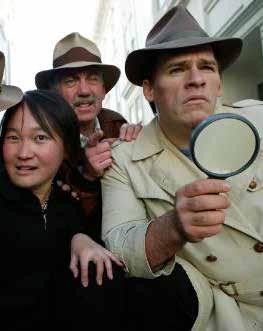
will share insights about the exhibition and how it came to be, and talk about individual pieces in the show.A Sense of Balance: The Sculpture of Stoney Lamar presents work from 1987 to the present. Uninspired by traditional turned wood vessel forms Stoney Lamar embarked on a personal exploration of the lathe and other tools of turners and woodworkers. This spirit of experimentation has firmly placed his work in the avantgarde of the wood turning world. Not only was he one of the first to use multi-axial turning, but eventually he added steel, color and distressed surface treatments. Free with admission, $8. 2 to 3 p.m. Museum of Craft and Design, 2569 Third Street. Information: sfmcd.org.
February 14 through March 22
Performance: Children are Forever (All Sales are Final!) by Julia Jackson Julia has never bought a baby before. Okay, she’s adopting, but the agency sure makes her feel like she’s buying one. Did you know some kids are discounted? A black baby- which is what Julia and her wife Amy are seeking costs half of a white baby. But just five days after signing up at the adoption agency, a birth mother chooses Julia and Amy to raise her baby. Oh and by the way, she’s in labor! While this play deals with some heavy topics, writer and star Julia Jackson -- a semifinalist at the San Francisco International Comedy Competition -- keeps the laughs coming as the drama increases. 8 p.m. Tickets $15-25. Stage Werx Theatre, 446 Valencia. Information: juliajackson.com
Film: Tim’s Vermeer
Inventor Tim Jenison seeks to understand the painting techniques used by Dutch Master Johannes Vermeer. Jenison, a Texas based inventor, attempts to solve one of the greatest mysteries in all
art: How did 17th century Dutch Master Johannes Vermeer (Girl with a Pearl Earring) manage to paint so photo-realistically –150 years before the invention of photography? The epic research project Jenison embarks on to test his theory is as extraordinary as what he discovers. Spanning eight years, Jenison’s adventure takes him to Delft, Holland, where Vermeer painted his masterpieces, on a pilgrimage to the North coast of Yorkshire to meet artist David Hockney, and even to Buckingham Palace to see a Vermeer masterpiece in the collection of the Queen. See Website for Times. Embarcadero Theater, One Embarcadero Center, Promenade Level. Information: landmarktheatres. com
Event: Chinese New Year Treasure Hunt
The unique Chinese New Year Treasure Hunt is the only urban sleuthing adventure of its kind. The Hunt is played on the streets of Chinatown, North Beach, and Telegraph Hill on the night of the annual Chinese New Year Parade Saturday, February 15, 2014. The Hunt begins at 4:30 pm (rain or shine) (check in at 3:30) in Justin Herman Plaza, located at the foot of Market St. at the Embarcadero (behind the Hyatt Regency Hotel) and ends at 9:00 pm. Tickets $12 kids, $42-50 adults. 4:30 to 9 p.m. Information: SFTreasureHunts. com or call 659.9606.
Celebration: Chinese New Year Parade
Named one of the top ten parades in the world the Chinese New Year Parade in San Francisco is one of the grandest night, illuminated parades in the country. Started in the 1860’s by the Chinese in San Francisco as a means to educate the community about their culture, the Parade and Festival have grown to be the largest celebration of Asian culture outside of Asia. Parade highlights include elaborate floats, lion dancers, folk dancers, costumed elementary school groups, marching bands, stilt walkers, Chinese acrobats, and a 268 foot long Golden Dragon (“Gum Lung.”) Note: Parade will also be televised live on KTVU Fox 2 and KTSF 26 (Chinese broadcast) 5:15 to 8 p.m. Free. ($30 for bleacher tickets). Market and Second Street to Kearny and Jackson Location of bleachers: Kearny Street (between Sacramento & California and between Pine & Bush). Information: 340.3055 or 982.3071
Celebration: Black History Month – 50 years with Jay’e Richardson’s Jazz Band
Join the celebration at the Bayview Operahouse, with Jay’e Richardson’s Jazz Band performing, readings by poet Jim Martin, Larry Ware and many others. Free. 7 p.m. Bayview Opera House, 4705 Third Street. Information: 647.5743 or email marylbooker@ att.net.
Live Music: Soul Delights
The ever popular Soul Delights are back in town. Come and enjoy the tunes. 7:30 to 9:30 p.m. Farley’s, 1315 – 18th Street.
Make Art: Sketch Friday ARCH will be hosting its first community modelsketching with costumed models posing for you to sketch or paint from. Participants should bring their own supplies and drawing board. fThere will be light refreshments and plenty of inspiration! $5.00 suggested donation. 5:30-8 p.m. ARCH
Drafting Supply 99 Missouri Street. If you are interested in being a model for this event, please contact Jenna at jenna@ archsupplies.com. Information: info@archsupplies.com
Kids: African American Festival
The Tenderloin AfterSchool Program presents an African American Festival! Come celebrate AfricanAmerican culture! Program open to children and teens and accompanying caregivers and parents. Free. 3 to 6 p.m. Main Library, 100 Larkin Street, Second Floor, Fisher Children’s Center. Information: sfpl.org
March 1
Open House: San Francisco Village for Members 60+
Learn more about San Francisco Village, a non-profit membership organization, that is dedicated to supporting active aging San Franciscans over 60. The Village provides a network of service providers to help with everything from transportation to meal prep to computer assistance. Members form a vibrant community and participate in classes, outings, and social events. Free. 1 to 3 p.m. Potrero Branch Library, 1616 20th Street. Information: sfvillage.org or info@sfvillage.org.

Last month, Dogpatch playground advocates raised another $20,000 of the $106,000 needed to build a playground at Woods Yard Park, along 22nd Street. To date $96,000 has been secured.
“We’re closing in on our funding milestone,” said Bruce Huie, a Dogpatch Playground Working Group member. Primarily made up of parents, the group consists of roughly a dozen people. “We’re trying to get ahead of the curve,” Huie said, referring to rapid development in the neighborhood, which has prompted increased demand for infrastructure, such as parks. Almost 350 residential units are being constructed near the intersection of Texas and 22nd streets. Two more developments are planned for Third and 20th streets, with even more on its way.
The proposed playground will be along 22nd Street, between Indiana and Minnesota streets, across the street from Rickshaw Bagworks.




Woods Yard Park is owned by the San Francisco Municipal Transportation Agency, which is collaborating with the Working Group on creating the playground.
“We don’t have a lot of space where we can build parks in the neighborhood,” said Alisha Holloway, a mom and Working Group member. “So, it’s important to take advantage of that,” she said of the Woods Yard Park property. The Working Group would ultimately like to see tables and seating installed at the playground site. “We really want to make it a community gathering space,” Huie said.
Of the nearly $100,000 already raised, $20,000 came from District 10 Supervisor Malia Cohen’s discretionary fund. Another $75,000 has been collected from community members and developers who are building in the neighborhood. “There’s a lot of energy around it,” Huie said.
“We are right on the cusp of reaching the goal,” said Brennan Cox, a landscape designer who is assisting with park design. “I’ve helped the group come up with the drawings and the vision.” Current plans call for Woods Yard Park’s sandy area to be transformed into the playground,
which will include a rubber surface as the base, benches on two sides and fencing all around.
“We’re absolutely blown away by the response,” said Lesley Grossblatt, another Working Group member. “It’s the start of revitalizing that whole block,” she said. “This is the first concrete project in that greater revitalization effort.”
The playground will cater to children two to five years old, but older kids will be able to use it too. According to Huie, the Working Group hopes to break ground on the project next month, and complete it by summer.



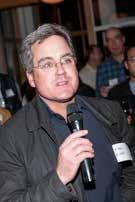



A MONTHLY UPDATE SPONSORED BY BRIDGE HOUSING
VOLUME 41 • FEBRUARY 2014
In January’s Rebuild Potrero column we outlined the key findings related to education and economic stability from a household needs assessment that was conducted amongst Potrero Terrace and Annex (PTA) residents. Additional findings regarding Safety, and Health and Well Being are presented below.
Safety is a major concern for residents. Repeated exposure to violence can lead to negative health outcomes such as posttraumatic stress disorder and chronic diseases. Living in unsafe conditions also affects employment outcomes and opportunities for social engagement among children and families. The types of crimes most frequently observed by residents were related to drug dealing and consumption as well as gun violence and home break-ins. A majority of respondents believe neighbors frequently witness a crime but do not report it and many believe that police surveillance of the area is inadequate.
Most of the survey respondents (91%) have either public or private health insurance with 50% relying on Medi-Cal for their health care needs. While a majority (77%) rated themselves as generally healthy, 2003-2005 data for zip code 94107, which includes PTA, showed far higher rates of acute care hospitalizations for adult and pediatric asthma, diabetes, lung disease, and heart failure than for San Francisco as a whole. These rates are more than double, and often triple, the rate for all San Franciscans.
Surveyed residents also rated their level of stress on a scale of 1 (always stressed out) to 10 (stress free). While one in five (19%) rated themselves a 10, the average rating was six (6). Nearly one-quarter (24%) are at the bottom end of the scale (1-4), indicating they experience a tremendous amount of stress in their lives.

More than just a physical redevelopment, Rebuild Potrero is taking a comprehensive approach to improving the health, education and economic outcomes for children and their families living in public housing. The assessment was conducted to better understand the current conditions and needs of families and to set the stage for development of an effective program and service delivery strategy.
For more information, visit our website at rebuildpotrero.com or e-mail us at potrero@bridgehousing.com
KILAMANJARO from page 8
of lava tubes and glacial valleys. Four hours later we were at our campsite, with soup and rice for dinner.
That night in my tent I woke up with a start, as if surfacing from a deep dive. I couldn’t catch my breath; my heart was racing. I laid in my sleeping bag, wondering what I’d gotten myself into. I fought against the panic rising in my chest.
Three decades previously, a few months after I’d been certified to scuba dive 30 feet below the surface of murky, algae-choked Monterey Bay, I found myself following the fast disappearing fins of one of my new companions on a 165 foot dive off the Cayman Islands. My heart pounded like a jackhammer; panic started to seize me. What was I doing diving to such depths, just after being certified?
I thought about surfacing, but knew that if I did I’d never hear the end of it from the group of gung-ho strangers I’d randomly joined on this packaged dive tour: a nuclear engineer who, even back then, confidently insisted that his day would come again; the dive master, who had seamless sliced into the water on his way to fetch the dive boat that was anchored offshore. I could die physically, crushed by thousands of pounds of pressure when I ran out of air; or I could die of embarrassment. I quickened my kick, speeding towards the fins below me before I lost them entirely.
Lying in my tent, on the second night on the mountain, I promised myself I wouldn’t keep climbing if I thought it would endanger my health. After a while, my heart beat slowed. But it was still hard to breath.
“This is what the start of an asthma attack feels like,” said Marissa, at breakfast the next day.
KILAMANJARO page 24
Babies remember nothing. Their short-term memory lasts as long as a soap bubble, which pops and disappears almost immediately after it’s formed. This weakness makes them well-known suckers for visual humor, of the peaka-boo variety.
When my nephew, Asa, was about 18-months old, he started fussing during a religious service my extended family was attending. Looking for just such an opportunity to escape the repetitive chanting, I carried him out of the synagogue, onto the street, in search of something engaging to do. I spotted a row of mechanical parking meters and strolled over, thinking that he might be amused by the whirling of the knob, and the clicking sound made by the purchase of time.
With a magician’s flare, I produced a quarter from my pocket, waved it in front of him, slid it into the coin slot, and twisted the knob. The quarter disappeared into the machine, but, without changing the meter time, it immediately popped out of a return slot. Startled, I grabbed the coin as it flew towards the pavement. Asa shrieked with laughter.
I grinned at him. My trick had been a hit, though mostly because of the unexpectedly broken meter. Even I was amused. Asa quickly settled back into a look of edgy boredom. I held the coin up to him again, slid it back into the meter, and twisted the knob. As it flew from the return slot Asa broke into a whole body giggle. I stuck the coin in again; more liquid laughter from Asa. I repeated the trick a half-dozen times. Each time Asa was delighted, as if he’d just seen the funniest thing in his life.
As far as I could tell, I could’ve stood at that meter, twisted the knob, and sparked Asa’s uninhibited laughter, forever. But I do have short-term memory. I got bored. After one more

“This was the second time my wife and I worked with Claudia and no surprise, she exceeded all of our expectations again... Claudia is the standard by which we will measure all future Realtors.” - Joseph, 2013 Claudia

hilarious spin cycle, I carried Asa back into the crowded synagogue and sat down. He fell asleep in my arms in a satisfied stupor.
Mindful of this experience, when Sara was fussing at around the same age I devised a new trick. I stuffed a tissue in my hand, and pretended to sneeze, blowing the soft paper into the air. Sara burst out laughing. I did it again; same results. I tried it a third time, but the tissue didn’t fly quite as high. Sara stared at me, her head slightly bobbling.
“Tough audience,” I said, as I stuffed the paper into my hand for another attempt. I “sneezed,” and the tissue floated high above Sara’s head. She shrieked with laughter.
I deployed this trick repeatedly throughout Sara’s toddlerhood. But if I didn’t do it right, she’d look at me blankly, continue her screaming, or turn away and grab at a toy. Ever mindful that I needed new material, I continued to hone the comedy of the abrupt: having a stuffed animal suddenly burp, producing an object from nowhere, stumbling or falling.
Soon enough, physical humor gave way to blunt word play. Like George Carlin’s seven words you can never say on network television, until she was close to six, Sara responded with various levels of laughter to any of the following terms, if timed correctly or placed in the right context: butt, booger, poop, fart (as a sound effect), pee-pee, and cack (as in a cat coughing up a hairball).
As she got closer to adolescence, word play became increasingly sophisticated, moving from knock-knock jokes, to puns, until finally, on a long road trip, we stumbled on a game we’d pull out anytime we were driving, and needed something to do.
“Beep, beep, beep, boop, beep, beep, boop. Ring, ring! Ring, ring!” I’d say.
“9.1.1., want’s your emergency,”
answered Sara, in a nasal drawl she thought mimicked what a seen-it-all operator might sound like.
“Um, um, I need to go to the bathroom, and I don’t know where the toilet is.”
“Sir, this is 9.1.1. Do you have an emergency?” Sara drawled, in mock exasperation.
“Yes, I told you, I need to go, really, badly.”
“Then go in the bushes!” She “slammed” the phone down angrily.
We’d go through several rounds of this joke, taking a turn as the caller— “I’m hungry, can you get me a snack;” “I’m feeling a little chilly, can you help me,” “Uh, who am I calling?”—or the initially bored but helpful, and then angry, 911 operator. Each of us would try to get the biggest laugh possible, until finally, we’d go happily silent.
Handbook Tips: Games Daddy’s Play
•There are plenty of comic ideas out there; just think like Jim Carey or the Three Stooges and you’ll be fine. Keep in mind, though, that just as suddenly as the tricks work, at some point —when your baby becomes a toddler; as they emerge into adolescence— they won’t anymore, and you’ll need to change your material again.
•When Sara got older we invented the “hug or punch” game. It’s easy to play: spot an actor, guy dressed up in a stuffed animal costume, or even relative and whisper “hug or punch?” The other player will choose based on what emotion the subject inspires. Caution: no actual punching! Though running up and hugging someone is generally encouraged.
This is an excerpt from The Daddy Handbook, a book by View editor Steven Moss, sections from which will appear in the paper throughout 2014. He’s looking for a publisher for this work; fellow parents are encouraged to write in with their experiences: editor@potreroview.net.

Last month a 33-year-old woman was the victim of an unsuccessful robbery on 18th Street. At around 11 p.m., after she walked onto 18th Street from Third, someone came up from behind and tried to snatch her purse. The victim clenched her bag; a car passing by may have startled the would-be robber, foiling the attempt. Officers responded to scene of the attempted mugging, but were unable to locate a suspect.
James Dudley, a criminal justice professor at San Francisco State University, theorized that as Dogpatch develops crime rates will diminish. “It’s the broken window theory,” said Dudley. According to the professor, who spent 32 years with the San Francisco Police Department, a neglected neighborhood draws crimes because the perpetrators believe they won’t get caught. But a “well-kept and tendered” community, Dudley said, is a different story.
Officer Gordon Shyy, SFPD media relations, was less sure. “It
would be hard to say economic development would improve safety. That would be speculating.” Instead, Shyy said, “With new construction comes new infrastructure such as street lighting” which can deter crime.
A retired SFPD deputy chief of patrol, Dudley now serves as vice president of SF SAFE, a “nonprofit organization that guides residents, business owners and community members to improve the quality of life in their neighborhoods.” If there is a problem in an area, Dudley said, SF SAFE can publish and distribute leaflets to provide information about a potential suspect. “It’s a great vehicle,” he said.
The organization publishes a variety of brochures that provide safety tips, which are available at http://sfsafe.org/. One tip is to keep family or friends abreast of travel schedules, including arrival times. Another is keeping personal identification documents concealed in different places. And the group suggests avoiding isolated areas or going out alone when it’s dark.

KILAMANJARO from page 23
I’d asked my sister about the wisdom of climbing the mountain given that she had asthma. She’d countered that she’d talked to her doctor about it, who said it was fine. And, she didn’t have that kind of asthma, she insisted, referring to the exercise-induced disease.
“I know it’s magical thinking,” Marissa said, “But I’m climbing this mountain in the hopes it’ll keep Elias safe. And, anyways, this is nothing compared to what he’s had to do in the Israeli army; hiking for days carrying 50 pounds of gear.”
“I dunno,” I said. “I think it’d be easier to schlep 50 pounds than climb at this altitude. Anyways, let’s both agree: if we don’t think we can make it, it’s okay to stop.”
“Agreed,” said Marissa. We spent a long day meandering up and down boulder-strewn passes on our way to Barranco Camp. When the cartoon-fluffy white clouds cleared we could see the top of Kilimanjaro. We hiked to a lava tower 15,190 feet high, and then climbed back down to end the day just 500 feet above where we started. We were mostly biding our time as our bodies acclimated to the altitude. Although my legs felt strong, a shadow of road weariness flickered over me. I hadn’t camped for even three days straight in several years.
The next day we hiked to Karanga Camp —13,500 feet—on our way to Barafu Camp—15,260 feet—which would serve as base for our final climb to the summit. It took less than four hours to get from Barranca to Karanga, a stroll on the beach given the previous days. Still, a bout of the runs had Asa dashing behind rocks a couple of times. Already slender, he looked like he was shedding pounds before our eyes. It didn’t help that he’d had a bout of the flu just before he’d left for Africa.
“I wonder whether there’s a trade-off between wearing down your body on the longer route, and getting to the summit sooner,” I said. “Maybe we should just go directly to Barafu, and cut a night off this trip.”
“Yeah,” said Marissa. “This is getting tiring, sleeping in tents. The outhouses are awful! And the food is terrible, with such small portions!” she joshed, riffing off an ancient joke from the Catskills. “But we need to get used to the altitude.”
“I guess,” I said. “But it almost feels like we’re getting weaker. And while they’re doing their best, the food reminds me of what it’s like to eat in Africa if you’re not staying at five star hotel; at some point it just doesn’t seem worth the effort to chew.”
Marissa grinned. We kept hiking, sucking in as much oxygen as possible from the thin air. The landscape continued to be dominated by boulders, with extraordinary views of Mount Meru and glacial valleys. As we traversed the ridges cold winds buffeted us. I was kept warm by my Patagonia fleece, and the occasional bursts of sunshine between the intermittent clouds.
That evening at Karanga Camp Simon
appeared in the dining tent looking blotchy and pale.
“You don’t look so good,” I said to him.
“I just have a headache,” Simon snapped, tightlipped. He looked at his plate. “And I’m not hungry.”
“Oh no,” Marissa exclaimed, “Altitude sickness!”
“No, it feels like sunstroke,” Simon countered.
“But you always wear a hat,” I said. “How could it be sunstroke?”
Simon grimaced at me. “I’m going to lie down,” he said. He stumbled to the tent he shared with Asa.
“That’s kind of ironic,” I said. “He’s the mountaineer in our group. What if he can’t make it?”
“Don’t say that,” barked Asa. “He’ll be fine. We’re all going to make it.”
We turned our attention to our dinner: the usual soup and rice with a meat sauce. Marissa’s sauce was meatless, since she was a vegetarian. She shifted the grains around on her plate.
“I can’t eat this,” she said. “I’m not hungry.” She put her fork down.
“Mom, you gotta eat,” said Asa. “You need the energy.”
She took a few more small bites before we all retired to our tents.
The next day Simon arrived at breakfast in the pink; whatever had slowed him down had passed. It was a good thing, because over the next 24 hours we’d either summit, or not. The goal was to hike to Barafu Camp, rest, and then depart at midnight for the final bid, straight up 4,000 feet to the top.
We made it to Barafu in roughly three hours, hiking through bouts of bitter winds. All of us were tired. Headaches floated like bubbles in our brains, and then popped. Patches of sunburn were visible on our faces and necks. Marissa was feeling bursts of nausea.
At lunch in the dining tent I swallowed several aspirins, hoping to tamp down any pre-summit pains.
“I don’t think that’s a good idea,” said Simon.
“Why,” I said. “It seems like it’d help with my circulation.”
A few minutes later I felt faint, my blood draining to my feet. “I don’t feel so good,” I said.
“You don’t look so good,” said Marissa. “You look white!”
“Yeah,” said Asa. “Your sunburn marks are gone. You actually looked kind of healthy.”
“I think it’s the aspirin,” I said. The fainting feeling was beginning to subside.
“I told you it wasn’t a good idea,” Simon declared.
That afternoon we slept fitfully in our tents. Mine was positioned with a glorious view of Mount Kibo. I stared at the mountain, picking animal shapes out of the huge clouds that floated by it, a sky feature that we’re deprived of in San Francisco.
One of the porters, who also served as our waiter, woke us up at 11 p.m. for a late-night snack before we ascended. It was freezing. I put on everything I had: long-underwear, two pairs of workout pants, cotton t.shirt, long
Agnes Corrigan was a seventh grader at Mission Grammar School— between 15th and 16th streets, on Mission—when her poem was published in Original Thoughts, Essays and Stanzas Written by the Pupils of the San Francisco Public Schools in 1894. She was living at 2307 Mariposa, just off Potrero Avenue, with her mother and five siblings. Getting to Mission Grammar was easier for Agnes than walking to the Potrero School at Minnesota and 21st street.
Agnes’ “Benefits of the Installment Plan” looks at the changing world of personal credit in the 1890s, seen through the eyes of a child. Although people have always borrowed money, it was often seen as a sign of moral weakness. During the 19th century, the industrial revolution made a wide variety of products available. Pianos became fashionable, there was bicycle craze, and suites of the latest furniture were shipped across the country.
In the 1880s, immigrants started coming to cities in gigantic waves, and were eager for the fruits of American prosperity: “three new rooms with brand new furniture.” Installment buying plans became commonplace by 1910.
“Loan sharks” were the darker side of late 20th century lending, charging exorbitant rates to an estimated 20 percent of American households. Lending regulations wouldn’t be implemented until the 1930s. The Userer’s Grip, a vivid silent movie by Thomas Edison on the subject, can be seen at www.library.hbs.edu/hc/credit/credit4f. html. As the Harvard Business School’s website points out, the film may be melodramatic, “...but its plot and the plight of its protagonists are eerily modern. Nearly one hundred years ago, unwary borrowing from unscrupulous lenders had the power to drive a family to the brink of disaster.”
A 954 Carolina 412 Connecticut 1133 – 19th Street 966 Carolina 514 Connecticut 1202-1204 19th Street 847 Kansas 1745 – 20th Street 415 Arkansas 324-326 Mississippi 481-483 Mississippi 437 Pennsylvania 1255 De Haro 417 Arkansas 1367-1369 Rhode Island 466 Missouri 534 Mississippi 232-234 Mississippi 1912-1914 20th Street 45 Southern Heights 701 Minnesota, #204 511 Mississippi 1420 De Haro 460 Vermont 775-775A Vermont 895 Wisconsin 1055 Carolina 86 Blair Terrace 357 Missouri 1536/1538 – 18th Street 609 Carolina VIEW 517 Mississippi 727 San Bruno 788 Carolina 1230 – 18th Street 656 Arkansas 1808 – 20th Street 2136 – 18th Street 285 Mississippi 458 Arkansas 640 De Haro 275 Arkansas 701 Minnesota #106 856-860 Wisconsin 454 San Bruno 771 Wisconsin 534 Mississippi 1056 Carolina 380 Connecticut 1919 Mariposa 616 Arkansas 1808 – 20th Street 1076 Rhode Island 1064 Carolina 763 Kansas 1471 Kansas 548-552 Vermont 903 Kansas, #101 1633 – 18th Street 1304 De Haro 825 Rhode Island 815-817 Rhode Island
 THE PAST: Available Right Now! Truly “the sweet life!” This contemporary jewel on the coveted North Slope offers the best mix of Italiana and San Francisco! 3 Bdrms on one level, 3 Baths, gorgeous Italian custom kitchen, skylights, designer window coverings, HUGE views of downtown! 2 decks, storage, garage.
THE PAST: Available Right Now! Truly “the sweet life!” This contemporary jewel on the coveted North Slope offers the best mix of Italiana and San Francisco! 3 Bdrms on one level, 3 Baths, gorgeous Italian custom kitchen, skylights, designer window coverings, HUGE views of downtown! 2 decks, storage, garage.
 Linenthal, Potrero Hill Archives Project. 25 THE POTRERO VIEW February 2014 Melinda Lee Potrero Hill Property Specialist Since 2002 DRE# 01344377 Join the long list of satisfied Buyers and Sellers who have chosen Melinda to represent them... Phone: (415) 338-0161 • Melinda.Lee@CAmoves.com www.MelindaLeeRealEstate.com No obligation consultation! I will personally evaluate your property and guide you to get the highest possible price. There’s no obligation, just seamless service from the Potrero Hill Expert.
Linenthal, Potrero Hill Archives Project. 25 THE POTRERO VIEW February 2014 Melinda Lee Potrero Hill Property Specialist Since 2002 DRE# 01344377 Join the long list of satisfied Buyers and Sellers who have chosen Melinda to represent them... Phone: (415) 338-0161 • Melinda.Lee@CAmoves.com www.MelindaLeeRealEstate.com No obligation consultation! I will personally evaluate your property and guide you to get the highest possible price. There’s no obligation, just seamless service from the Potrero Hill Expert.

 La Dolce Vita! 444 Arkansas Offered at $1,649,000 Gorgeous Home - Move In Ready! 3 Bedrooms & Custom Tile Bath on Main Level. Formal Living & Dining, Fireplace, Gourmet Kitchen, Lower Entertainment Room with Bath, Wet Bar, New Lighting, Full-Wall Doors Out to Private Landscaped Garden & Hot Tub. Beautifully Updated Throughout, Attention to Detail. 2 Car Side by Side Garage, Storage!
La Dolce Vita! 444 Arkansas Offered at $1,649,000 Gorgeous Home - Move In Ready! 3 Bedrooms & Custom Tile Bath on Main Level. Formal Living & Dining, Fireplace, Gourmet Kitchen, Lower Entertainment Room with Bath, Wet Bar, New Lighting, Full-Wall Doors Out to Private Landscaped Garden & Hot Tub. Beautifully Updated Throughout, Attention to Detail. 2 Car Side by Side Garage, Storage!
 Sizzling Property on Cool Potrero Hill! 753 Kansas Street Offered at $1,795,000 Call me today for details and showings. Potrero is on fire! Call me for a free estimate of YOUR property. (415) 338-0161
Hot Spot! –Garden Condo 1531 20th Street Offered at $459,000
20th Street Jewel Box! 1-Bdrm | 1-Bath remodeled condo with open floor plan. Slate flooring and new carpet ~ walk out to beautifully-landscaped garden. Steps to Good Life Grocery, Thinkers Café, shops & restaurants. Quick to Downtown & Peninsula!
Sizzling Property on Cool Potrero Hill! 753 Kansas Street Offered at $1,795,000 Call me today for details and showings. Potrero is on fire! Call me for a free estimate of YOUR property. (415) 338-0161
Hot Spot! –Garden Condo 1531 20th Street Offered at $459,000
20th Street Jewel Box! 1-Bdrm | 1-Bath remodeled condo with open floor plan. Slate flooring and new carpet ~ walk out to beautifully-landscaped garden. Steps to Good Life Grocery, Thinkers Café, shops & restaurants. Quick to Downtown & Peninsula!

Bayview Police Station Captain’s Community Meeting is held on the first Tuesday of each month at the Bayview Station, 201 Williams Avenue. Next meeting: February 4th, 6 p.m.
Dogpatch Neighborhood Association usually meets the second Tuesday of each odd-numbered month. Next meeting: February 11th. Voting membership is open to anyone living in or owning property or a business in Dogpatch. For more information or to join/pay online: mydogpatch.org
Friends of Franklin Square Join the Friends of Franklin Square to help improve our local park! We need your ideas and input to update the master plan and to help seek grant money to improve the park. Concerned about park safety and cleanliness? Want the soccer field to be re-carpeted? Interested in getting a dog friendly area built? Now is your chance to make it happen! Meet your neighbors and share ideas. Free snacks and drinks provided. We will also have a mini-trivia contest with prizes from our neighborhood businesses! For more information contact: friendsoffranklinsquare@gmail. com. Next Meeting: February 26, 7 p.m, Sports Basement Store, 1590 Bryant Street) in the Grotto Room located on the 5th Floor
McKinley Square Community Group is a communication and discussion group regarding events and activities, clean up days, improvement and beautification, and other concerns, such as crime in the neighborhood. MSCA board meets approximately quarterly on the second Wednesday of the month. Look to the online discussion group for postings of upcoming meetings. http://groups.yahoo. com/group/McKinleySquareCommunity. Locations vary between the Potrero Hill Neighborhood House and Downtown High School. For updates, including sustainable gardening and park workdays, and our grant progress, check out the MSCA blog at: http://mckinleysquareblog.blogspot.com.
Potrero Boosters Neighborhood Association meets the last Tuesday of each month at 7 p.m. (social time begins at 6:45 p.m.) in the wheelchair-accessible Potrero Hill Neighborhood House, 953 De Haro Street. For more information: www.potreroboosters.org or email president@potreroboosters.org. Next meeting: February 25th, 7 p.m.
Potrero Dogpatch Merchant’s Association meets the second Tuesday of each month at 10 a.m. at Goat Hill Pizza, corner of Connecticut and 18th streets. Visit www.potrerohill.biz or call 341.8949. Next meeting: February 11th, 10 a.m.
Potrero Hill Democratic Club meets the first Tuesday of each month at 7 p.m. at the Potrero Hill Neighborhood House, 953 De Haro Street. For more information: 648.6740, www.PHDemClub.org. Next meeting: February 4th, 7 p.m.
Potrero Hill Garden Club usually meets the last Sunday of the month at 11 a.m. for a potluck lunch in a local home or garden. Discussions are held on organic, edible, or ornamental gardening appropriate for Potrero Hill’s microclimate. Call 648.1926 for details.
Starr King Open Space The third Saturday of each month neighbors and friends of SKOS are welcome to get down and dirty while sprucing up the open space. Come learn about our native flower’s while being a steward for our land. For more information:www. starrkingopenspace.org; email the Board of Directors at starrkingboard@gmail.com; voice mail 415-6336-SKO (756).

Home Services
TOM’S PLUMBING Tom’s been satisfying Potrero Hill customers for over 30 years. All plumbing needs handled promptly and efficiently at a very low cost. Keep it local and call Tom Keats! 415-824-3538
CARPENTRY & PAINTING also: plumbing, seismic/structural work, stucco, roof repairs & gutter cleaning, tree trimming. www.FarWestConstr.com Jim Kennedy, 415-276-1990 Ca. Lic. 751689
Housekeeping
CLEANING PROFESSIONAL 27 years Experience. Apartments, homes or offices and Apartment Buildings. Roger Miller 415-794-4411 References
Photography
FREE PORTRAITS BY PROFESSIONALLY TRAINED HOBBYIST I am a retired professional who now does portrait photography as my hobby/passion. I have a studio on Potrero Hill with top quality equipment where I do free portraits & prints for families or individuals. There
is no catch, professional quality for free, and fun for all. Contact me at alcastino@ mac.com and I will send a link to sample photos.
Rentals
YOUR GARDEN APARTMENT Place an classified ad in the View , office@ potreroview.net.
Technology Services
COMPUTER PROBLEMS DRIVING
YOU BUGGY? Problems fixed! 25 years of industry experience. Personal IT consulting to small businesses or busy professionals. We can install and/or help shop for computer/network/printer or setup/troubleshoot wireless networks. If you’re not technical, don’t worry - we are. Rob 415.244.3305 rob@sfcomputech. com.
View Classified Ads
Go to potreroview.net & follow the instructions to place ad, or email office@ potreroview.net. Mail ads to 2325 Third Street, Suite 344, San Francisco, CA 94107.
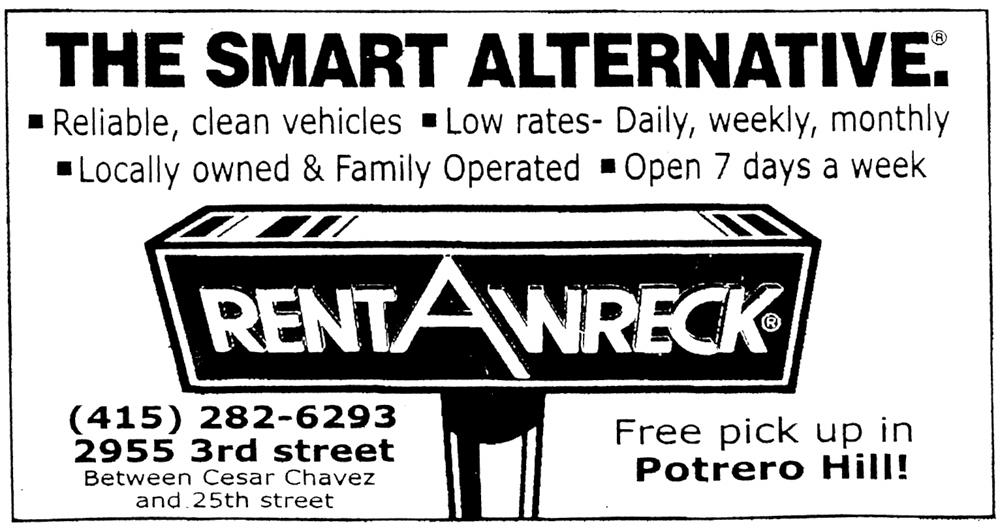

sleeve shirt, fleece, ski parka, alpine hat and gloves. Though it was less high-tech than the others, who had been better outfitted by Simon, I was warm enough as I scrambled out of my tent.
The cook seemed to have prepared all of the remaining food supplies: millet porridge—which, after a halfdozen days, none of us could choke down—French toast, and scrambled eggs. Though we suffered from Africainduced loss of appetite, we ate as much as we could. Marissa even seemed to enjoy the eggs.
At midnight Adronis led us past dozens of other encampments, on our way to the summit, our headlamps illuminating the rocky ground. The night sky was stunning, pinpricked by millions of stars, with patterns of familiar constellations—Orion; Scorpio —brilliantly outlined. As we passed the ranger’s cabin, I looked at the top of the mountain. Short lines of lights weaved their way up the slope; other climbers, their headlamps switched on, were making their attempts. It felt like we’d entered into another dimension, the air heavy yet thin, gravity pressing down like a leaden blanket. Or perhaps we’d become characters in a darkly animated feature by Hayao Miyazaki.
We shuffled like zombies, breathing heavily. Adronis in the front, our assistant guide, Michael, followed in the rear. Sometimes we passed other groups leaning against rocks; occasionally they elbowed past us. Everyone was moving slowly, heads down. As we shuffled forward I’d feel overheated — my heart pounding in a familiar way when I got too hot — which I tried to regulate by taking off my hat and gloves, and unzipping my parka, only to bundle up again went it got too cold.
“Keep going,” Adronis sang out. “Don’t fall asleep.”
“I feel nauseous,” Marissa said, sitting on a rock. “I have to stop.” She doubled over, breathing heavily. “I think I’m going to throw up!”
“If she has to quit, support her,” I said to Asa and Simon, who stood next to me in the darkness. They nodded.
Marissa got up; we continued our zombie shuffle. Adronis regularly exhorted us to keep going. Simon, checking his GPS, announced that we didn’t have much further to go. Marissa complained about her stomach, sat down, climbed for a while, and then sat down again.
Dawn started to break, with a dim burst of sun illuminating the corners of
a mass of clouds that towered towards us. As I stopped to admire the view, I noted that my heart was beating even faster than before. I turned to keep climbing; the pressure on my heart increased.
“We’re almost there,” shouted Adronis. “Keep going!”
I struggled behind the other three. It now felt like God had reached into my chest, grabbed my heart, and was squeezing. I sat on a boulder.
“Keep going,” I waved at the group. “I gotta rest. I’ll try to catch-up.” I sat and watched as the sun continued its slow ascent. It was as beautiful a sunrise as I’d ever seen. The sky looked like it had expanded; sunrays softly filtered through herds of clouds. The pressure on my heart continued. Michael came back to check on me.
“Are you okay?” he asked.
“Yeah, it’s my heart,” I said.
“Do you have heart problems?
“No, but I don’t want to start now.”
He looked up the mountain. “It’s only ten feet to the summit. You should try to get there.”
“Okay,” I said, getting to my feet. It wasn’t far to the top, but God hadn’t released my heart from his grip. I handed my camera to Michael. “Please give this to Simon.” He hurried up the slope, seemingly unmolested by the altitude.
I trudged to the top, and sat down on a boulder. An elderly guide, accompanying a thirty-something Asian woman, ambled over to me.
“You made it to Stella Point, 18,800 feet! It’s just a little further to Uhuru Peak. Just 500 feet more, and you’re on the top of Africa!” The guide gently buttoned the top of my coat, to make sure I was warm, and patted my chest and shoulders.
“Is it much of a climb,” I asked him.
“No, just a small incline. You’ll be there before you know it.”
I didn’t move. My heart still felt like it was in God’s grip. I looked at the path leading to Uhuru Peak, down which my relatives had disappeared. I wondered whether I should try to make it, while simultaneously questioning why I’d want to do that. Debbie would kill me if I died on the mountain. Before I made up my mind, Adronis and Michael appeared.
“You’re going down with Michael,” shouted Adronis. “Now!”
“Okay,” I said.
As soon as I got below 18,000 feet the pressure on my heart released. I was tired, but no longer in any pain. Michael skidded down the loose stones like he was a dirt skiing; I followed as fast as I could, enjoying the view, and

the sensation that I was free from the need to summit. I’d gone as far as I could, and that was good enough.
I looked over at the string of groups, still ascending in the early morning light.
“Do you think they’ll make it,” I asked Michael.
“Probably not,” he said. “At this point they’ve suffered too much: dizziness, nausea, and who knows what else. Once the sun comes up they can see the top of the mountain, and how far away from it they are.” He looked up the slope, and shook he’s head. “They’ve suffered too much,” he repeated.
Marissa, Simon, and Asa reached Uhuru Peak, with its spectacular view of the glacier landscape. They stayed less than 10 minutes before
following me on the long hike down the mountain.
“I had to sit down twice on the final trail,” said Marissa. “I was so nauseous. You did the right thing, going back. And you climbed the mountain without sticks! Pretty impressive.”
What we carry up a mountain, we can bring back down, or leave at the top. Asa and Simon brought their youth, which they kept with them afterwards, perhaps to take them to another peak. Marissa lugged her worries about Elias, a steep walking prayer to keep him safe. As for me, I traveled up the mountain on legs made strong by a lifetime of journeys, and left at the summit any further need to test my heart against such challenges. I need that muscle for other things.








